Progress in Indentation Study of Materials via Both Experimental and Numerical Methods
Abstract
:1. Introduction
2. Nanoindentation Facilities
3. Application of Nanoindentation in Materials
4. Nanoindentation Size Effect of Materials
5. Simulations of Mechanical Behaviours of Materials Undergoing Nanoindentation
5.1. Conventional Finite Element Method (FEM) Simulations
5.2. Crystal Plasticity FEM Simulation
6. Conclusions
Acknowledgments
Conflicts of Interest
References
- Tabor, D. The Hardness of Metals; Oxford University Press: Oxford, UK, 1951. [Google Scholar]
- Bhushan, B. Handbook of Micro/Nanotribology, 2nd ed.; CRC Press: Boca Raton, FL, USA, 1999. [Google Scholar]
- Brinell, J.A. Way of determining the hardness of bodies and some applications of the same. Teknisk Tidskrift 1900, 5, 69. [Google Scholar]
- Wahlberg, A. Brinell’s method of determining hardness and other properties of iron and steel. J. Iron. Steel Inst. 1901, 59, 243. [Google Scholar]
- Meyer, E. Investigations of hardness testing and hardness. Phys. Z 1908, 9, 66. [Google Scholar]
- Smith, R.; Sandland, G. An accurate method of determining the hardness of metals, with particular reference to those of a high degree of hardness. Proc. Inst. Mech. Eng. 1922, 102, 623. [Google Scholar] [CrossRef]
- Hutchings, I.M. The contributions of David Tabor to the science of indentation hardness. J. Mater. Res. 2009, 24, 581–589. [Google Scholar] [CrossRef]
- Tabor, D. A simple theory of static and dynamic hardness. Proc. R. Soc. Lond. Ser. A 1948, 192, 247–274. [Google Scholar] [CrossRef]
- Johnson, K.L. The correlation of indentation experiments. J. Mech. Phys. Solids 1970, 18, 115–126. [Google Scholar] [CrossRef]
- King, R.F.; Tabor, D. The effect of temperature on the mechanical properties and the friction of plastics. Proc. Phys. Soc. B 1953, 66, 728–736. [Google Scholar] [CrossRef]
- Pascoe, M.W.; Tabor, D. The Friction and Deformation of Polymers. Proc. R. Soc. A 1956, 235, 210–224. [Google Scholar] [CrossRef]
- King, R.F.; Tabor, D. The strength properties and frictional behaviour of brittle solids. Proc. R. Soc. A 1954, 223, 225–238. [Google Scholar] [CrossRef]
- Atkins, A.G.; Tabor, D. Mutual Indentation Hardness of Single-Crystal Magnesium Oxide at High Temperatures. J. Am. Ceram. Soc. 1967, 50, 195–198. [Google Scholar] [CrossRef]
- Fischer-Cripps, A.C. A review of analysis methods for sub-micron indentation testing. Vacuum 2000, 58, 569–585. [Google Scholar] [CrossRef]
- Available online: http://www.nanoindentation.cornell.edu/Machine/commercial_machine.htm (accessed on 1 December 2013).
- Fischer-Cripps, A.C. The IBIS Handbook of Nanoindentation; Fischer-Cripps Laboratories Pty Ltd.: Sydney, Australia, 2009. [Google Scholar]
- Kim, D.K. Nanoindentation Lecture 1 Basic Principle, KAIST: Daejeon, Korea. Available online: http://szft.elte.hu/oktat/www/mikronano/Nano_indentation.pdf (accessed on 17 August 2017).
- Oliver, W.C.; Pharr, G.M. An Improved Technique for Determining Hardness and Elastic-Modulus Using Load and Displacement Sensing Indentation Experiments. J. Mater. Res. 1992, 7, 1564–1583. [Google Scholar] [CrossRef]
- Oliver, W.C.; Pharr, G.M. Measurement of hardness and elastic modulus by instrumented indentation: Advances in understanding and refinements to methodology. J. Mater. Res. 2004, 19, 3–20. [Google Scholar] [CrossRef]
- Kucharski, S.; Mroz, Z. Identification of yield stress and plastic hardening parameters from a spherical indentation test. Int. J. Mech. Sci. 2007, 49, 1238–1250. [Google Scholar] [CrossRef]
- Kruzic, J.J.; Kim, D.K.; Koester, K.J.; Ritchie, R.O. Indentation techniques for evaluating the fracture toughness of biomaterials and hard tissues. J. Mech. Behav. Biomed. 2009, 2, 384–395. [Google Scholar] [CrossRef] [PubMed]
- Huber, N.; Tsakmakis, C. Experimental and theoretical investigation of the effect of kinematic hardening on spherical indentation. Mech. Mater. 1998, 27, 241–248. [Google Scholar] [CrossRef]
- Masri, R.; Durban, D. Cylindrical cavity expansion in compressible Mises and Tresca solids. Eur. J. Mech. A-Solids 2007, 26, 712–727. [Google Scholar] [CrossRef]
- Mata, M.; Anglada, M.; Alcala, J. A hardness equation for sharp indentation of elastic-power-law strain-hardening materials. Philos. Mag. A 2002, 82, 1831–1839. [Google Scholar] [CrossRef]
- Hill, R. The Mathematical Theory of Plasticity; Oxford University Press: Oxford, UK, 1950. [Google Scholar]
- Marsh, D.M. Plastic Flow in Glass. Proc. R. Soc. A 1964, 279, 420–435. [Google Scholar] [CrossRef]
- Rodriguez, J.; Rico, A.; Otero, E.; Rainforth, W.M. Indentation properties of plasma sprayed Al2O3-13% TiO2 nanocoatings. Acta Mater. 2009, 57, 3148–3156. [Google Scholar] [CrossRef]
- Mencik, J.; Munz, D.; Quandt, E.; Weppelmann, E.R.; Swain, M.V. Determination of elastic modulus of thin layers using nanoindentation. J. Mater. Res. 1997, 12, 2475–2484. [Google Scholar] [CrossRef]
- Swain, M.V.; Mencik, J. Mechanical Property Characterization of Thin-Films Using Spherical Tipped Indenters. Thin Solid Films 1994, 253, 204–211. [Google Scholar] [CrossRef]
- Jonsson, B.; Hogmark, S. Hardness Measurements of Thin-Films. Thin Solid Films 1984, 114, 257–269. [Google Scholar] [CrossRef]
- Opitz, A.; Ahmed, S.I.U.; Schaefer, J.A.; Scherge, M. Nanofriction of silicon oxide surfaces covered with thin water films. Wear 2003, 254, 924–929. [Google Scholar] [CrossRef]
- Kim, J.H.; Yeon, S.C.; Jeon, Y.K.; Kim, J.G.; Kim, Y.H. Nano-indentation method for the measurement of the Poisson’s ratio of MEMS thin films. Sens. Actuator A-Phys. 2003, 108, 20–27. [Google Scholar] [CrossRef]
- Lou, J.; Shrotriya, P.; Buchheit, T.; Yang, D.; Soboyejo, W.O. Nanoindentation study of plasticity length scale effects in LIGA Ni microelectromechanical systems structures. J. Mater. Res. 2003, 18, 719–728. [Google Scholar] [CrossRef]
- Chicot, D.; Demarecaux, P.; Lesage, J. Apparent interface toughness of substrate and coating couples from indentation tests. Thin Solid Films 1996, 283, 151–157. [Google Scholar] [CrossRef]
- Drory, M.D.; Hutchinson, J.W. Measurement of the adhesion of a brittle film on a ductile substrate by indentation. Proc. R. Soc. Lond. A 1953, 452, 2319–2341. [Google Scholar] [CrossRef]
- Yamazaki, Y.; Kuga, S.; Yoshida, T. Evaluation of interfacial strength by an instrumented indentation method and its application to an actual TBC vane. Acta Metall. Sin.-Engl. 2011, 24, 109–117. [Google Scholar]
- Bartsch, M.; Mircea, I.; Suffner, J.; Baufeld, B. Interfacial fracture toughness measurement of thick ceramic coatings by indentation. Key Eng. Mater. 2005, 290, 183–190. [Google Scholar] [CrossRef]
- Vasinonta, A.; Beuth, J.L. Measurement of interfacial toughness in thermal barrier coating systems by indentation. Eng. Fract. Mech. 2001, 68, 843–860. [Google Scholar] [CrossRef]
- Yamazaki, Y.; Kuga, S.-I.; Jayaprakash, M. Interfacial Strength Evaluation Technique for Thermal Barrier Coated Components by Using Indentation Method. Procedia Eng. 2011, 10, 845–850. [Google Scholar] [CrossRef]
- Wang, Y.; Raabe, D.; Kluber, C.; Roters, F. Orientation dependence of nanoindentation pile-up patterns and of nanoindentation microtextures in copper single crystals. Acta Mater. 2004, 52, 2229–2238. [Google Scholar] [CrossRef]
- Saka, H.; Nagaya, G. Plan-View Transmission Electron-Microscopy Observation of a Crack-Tip in Silicon. Philos. Mag. Lett. 1995, 72, 251–255. [Google Scholar] [CrossRef]
- Lloyd, S.J.; Castellero, A.; Giuliani, F.; Long, Y.; McLaughlin, K.K.; Molina-Aldareguia, J.M.; Stelmashenko, N.A.; Vandeperre, L.J.; Clegg, W.J. Observations of nanoindents via cross-sectional transmission electron microscopy: A survey of deformation mechanisms. Proc. R. Soc. A-Math. Phys. 2005, 461, 2521–2543. [Google Scholar] [CrossRef]
- Lloyd, S.J.; Molina-Aldareguia, J.M.; Clegg, W.J. Deformation under nanoindents in sapphire, spinel and magnesia examined using transmission electron microscopy. Philos. Mag. A 2002, 82, 1963–1969. [Google Scholar] [CrossRef]
- Rester, M.; Motz, C.; Pippan, R. Indentation across size scales—A survey of indentation-induced plastic zones in copper {111} single crystals. Scr. Mater. 2008, 59, 742–745. [Google Scholar] [CrossRef]
- Zaafarani, N.; Raabe, D.; Singh, R.N.; Roters, F.; Zaefferer, S. Three-dimensional investigation of the texture and microstructure below a nanoindent in a Cu single crystal using 3D EBSD and crystal plasticity finite element simulations. Acta Mater. 2006, 54, 1863–1876. [Google Scholar] [CrossRef]
- Pharr, G.M.; Herbert, E.G.; Gao, Y.F. The Indentation Size Effect: A Critical Examination of Experimental Observations and Mechanistic Interpretations. Annu. Rev. Mater. Res. 2010, 40, 271–292. [Google Scholar] [CrossRef]
- Li, L.; Zhou, Q.; Zhou, Y.Y.; Cao, J.G. Numerical study on the size effect in the ultra-thin sheet’s micro-bending forming process. Mater. Sci. Eng. A 2009, 499, 32–35. [Google Scholar] [CrossRef]
- Fleck, N.A.; Muller, G.M.; Ashby, M.F.; Hutchinson, J.W. Strain Gradient Plasticity—Theory and Experiment. Acta Metall. Mater. 1994, 42, 475–487. [Google Scholar] [CrossRef]
- Stolken, J.S.; Evans, A.G. A microbend test method for measuring the plasticity length scale. Acta Mater. 1998, 46, 5109–5115. [Google Scholar] [CrossRef]
- Gau, J.T.; Principe, C.; Yu, M. Springback behavior of brass in micro sheet forming. J. Mater. Process. Technol. 2007, 191, 7–10. [Google Scholar] [CrossRef]
- Geiger, M.; Kleiner, M.; Eckstein, R.; Tiesler, N.; Engel, U. Microforming. CIRP Ann.-Manuf. Technol. 2001, 50, 445–462. [Google Scholar] [CrossRef]
- Kals, T.A.; Eckstein, R. Miniaturization in sheet metal working. J. Mater. Process. Technol. 2000, 103, 95–101. [Google Scholar] [CrossRef]
- Saotome, Y.; Yasuda, K.; Kaga, H. Microdeep drawability of very thin sheet steels. J. Mater. Process. Technol. 2001, 113, 641–647. [Google Scholar] [CrossRef]
- Mott, B.W. Microindentation Hardness Testing; Butterworths Scientific Publications: London, UK, 1956. [Google Scholar]
- Bückle, H. Progress in micro-indentation hardness testing. Metall. Rev. 1959, 4, 49–100. [Google Scholar] [CrossRef]
- Gane, N. Direct Measurement of Strength of Metals on a Sub-Micrometre Scale. Proc. R. Soc. Lond. Ser.-A 1970, 317. [Google Scholar] [CrossRef]
- Kiener, D.; Durst, K.; Rester, M.; Minor, A.M. Revealing deformation mechanisms with nanoindentation. JOM-US 2009, 61, 14–23. [Google Scholar] [CrossRef]
- Gerberich, W.W.; Tymiak, N.I.; Grunlan, J.C.; Horstemeyer, M.F.; Baskes, M.I. Interpretations of indentation size effects. J. Appl. Mech. 2002, 69, 433–442. [Google Scholar] [CrossRef]
- Bull, S.J. On the origins and mechanisms of the indentation size effect. Z. Metallkd. 2003, 94, 787–792. [Google Scholar] [CrossRef]
- Zhu, T.T.; Bushby, A.J.; Dunstan, D.J. Materials mechanical size effects: A review. Mater. Technol. 2008, 23, 193–209. [Google Scholar] [CrossRef]
- Sangwal, K. On the reverse indentation size effect and microhardness measurement of solids. Mater. Chem. Phys. 2000, 63, 145–152. [Google Scholar] [CrossRef]
- Voyiadjis, G.Z.; Peters, R. Size effects in nanoindentation: An experimental and analytical study. Acta Mech. 2010, 211, 131–153. [Google Scholar] [CrossRef]
- Ashby, M.F. Deformation of Plastically Non-Homogeneous Materials. Philos. Mag. 1970, 21, 399–424. [Google Scholar] [CrossRef]
- Nye, J.F. Some geometrical relations in dislocated crystals. Acta Metall. Mater. 1953, 1, 153–162. [Google Scholar] [CrossRef]
- Nix, W.D.; Gao, H.J. Indentation size effects in crystalline materials: A law for strain gradient plasticity. J. Mech. Phys. Solids 1998, 46, 411–425. [Google Scholar] [CrossRef]
- Wiedersich, H. Hardening mechanisms and the theory of deformation. JOM 1964, 16, 425–430. [Google Scholar]
- Ebisu, T.; Horibe, S. Analysis of the indentation size effect in brittle materials from nanoindentation load-displacement curve. J. Eur. Ceram. Soc. 2010, 30, 2419–2426. [Google Scholar] [CrossRef]
- Ma, Q.; Clarke, D.R. Size dependent hardness of silver single crystals. J. Mater. Res. 1995, 10, 853–863. [Google Scholar] [CrossRef]
- Poole, W.J.; Ashby, M.F.; Fleck, N.A. Micro-hardness of annealed and work-hardened copper polycrystals. Scr. Mater. 1996, 34, 559–564. [Google Scholar] [CrossRef]
- Stelmashenko, N.A.; Walls, M.G.; Brown, L.M.; Milman, Y.V. Microindentations on W and Mo Oriented Single-Crystals—An Stm Study. Acta Metall. Mater. 1993, 41, 2855–2865. [Google Scholar] [CrossRef]
- Gao, H.; Huang, Y.; Nix, W.D. Modeling plasticity at the micrometer scale. Naturwissenschaften 1999, 86, 507–515. [Google Scholar] [CrossRef] [PubMed]
- Gao, H.; Huang, Y.; Nix, W.D.; Hutchinson, J.W. Mechanism-based strain gradient plasticity—I. Theory. J. Mech. Phys. Solids 1999, 47, 1239–1263. [Google Scholar] [CrossRef]
- Acharya, A.; Bassani, J.L. Lattice incompatibility and a gradient theory of crystal plasticity. J. Mech. Phys. Solids 2000, 48, 1565–1595. [Google Scholar] [CrossRef]
- Huang, Y.; Gao, H.; Nix, W.D.; Hutchinson, J.W. Mechanism-based strain gradient plasticity—II. Analysis. J. Mech. Phys. Solids 2000, 48, 99–128. [Google Scholar] [CrossRef]
- Gurtin, M.E. A gradient theory of single-crystal viscoplasticity that accounts for geometrically necessary dislocations. J. Mech. Phys. Solids 2002, 50, 5–32. [Google Scholar] [CrossRef]
- Demir, E.; Raabe, D.; Zaafarani, N.; Zaefferer, S. Investigation of the indentation size effect through the measurement of the geometrically necessary dislocations beneath small indents of different depths using EBSD tomography. Acta Mater. 2009, 57, 559–569. [Google Scholar] [CrossRef]
- Rester, M.; Motz, C.; Pippan, R. Microstructural investigation of the volume beneath nanoindentations in copper. Acta Mater. 2007, 55, 6427–6435. [Google Scholar] [CrossRef]
- Kiener, D.; Pippan, R.; Motz, C.; Kreuzer, H. Microstructural evolution of the deformed volume beneath microindents in tungsten and copper. Acta Mater. 2006, 54, 2801–2811. [Google Scholar] [CrossRef]
- Durst, K.; Backes, B.; Goken, M. Indentation size effect in metallic materials: Correcting for the size of the plastic zone. Scr. Mater. 2005, 52, 1093–1097. [Google Scholar] [CrossRef]
- Smedskjaer, M.M. Indentation size effect and the plastic compressibility of glass. Appl. Phys. Lett. 2014, 104, 251906. [Google Scholar] [CrossRef]
- Liu, M.; Xu, W.; Bai, J.; Chua, C.K.; Wei, J.; Li, Z.; Gao, Y.; Kim, D.H.; Zhou, K. Investigation of the size effect for photonic crystals. Nanotechnology 2016, 27, 405703. [Google Scholar] [CrossRef] [PubMed]
- Onitsch, E.M. The present status of testing the hardness of materials. Mikroskopie 1956, 95, 12–14. [Google Scholar]
- Lee, C.H.; Masaki, S.; Kobayashi, S. Analysis of ball indentation. Int. J. Mech. Sci. 1972, 14, 417–426. [Google Scholar] [CrossRef]
- Fischer-Cripps, A.C. Critical review of analysis and interpretation of nanoindentation test data. Surf. Coat. Technol. 2006, 200, 4153–4165. [Google Scholar] [CrossRef]
- Sakai, M. Energy principle of the indentation-induced inelastic surface deformation and hardness of brittle materials. Acta Metall. Mater. 1993, 41, 1751–1758. [Google Scholar] [CrossRef]
- Gong, J.; Wu, J.; Guan, Z. Examination of the indentation size effect in low-load vickers hardness testing of ceramics. J. Eur. Ceram. Soc. 1999, 19, 2625–2631. [Google Scholar] [CrossRef]
- Ren, X.J.; Hooper, R.M.; Griffiths, C.; Henshall, J.L. Indentation size effect in ceramics: Correlation with H/E. J. Mater. Sci. Lett. 2003, 22, 1105–1106. [Google Scholar] [CrossRef]
- Gogotsi, G.A.; Dub, S.N.; Lomonova, E.E.; Ozersky, B.I. Vickers and Knoop Indentation Behavior of Cubic and Partially-Stabilized Zirconia Crystals. J. Eur. Ceram. Soc. 1995, 15, 405–413. [Google Scholar] [CrossRef]
- Sahin, O.; Uzun, O.; Sopicka-Lizer, M.; Gocmez, H.; Kolemen, U. Analysis of load-penetration depth data using Oliver-Pharr and Cheng-Cheng methods of SiAlON-ZrO(2) ceramics. J. Phys. D Appl. Phys. 2008, 41, 035305. [Google Scholar] [CrossRef]
- Kolemen, U. Analysis of ISE in microhardness measurements of bulk MgB2 superconductors using different models. J. Alloy Compd. 2006, 425, 429–435. [Google Scholar] [CrossRef]
- Peng, Z.; Gong, J.; Miao, H. On the description of indentation size effect in hardness testing for ceramics: Analysis of the nanoindentation data. J. Eur. Ceram. Soc. 2004, 24, 2193–2201. [Google Scholar] [CrossRef]
- Gong, J.H.; Zhao, Z.; Guan, Z.D.; Miao, H.Z. Load-dependence of Knoop hardness of Al2O3-TiC composites. J. Eur. Ceram. Soc. 2000, 20, 1895–1900. [Google Scholar] [CrossRef]
- Li, H.; Bradt, R.C. The Microhardness Indentation Load Size Effect in Rutile and Cassiterite Single-Crystals. J. Mater. Sci. 1993, 28, 917–926. [Google Scholar] [CrossRef]
- Samuels, L.E. Microindentation in Metals; ASTM STP: Philadelphia, PA, USA, 1986; pp. 5–25. [Google Scholar]
- Sargent, P.M. Use of the Indentation Size Effect on Microhardness for Materials Characterization; ASTM STP: Philadelphia, PA, USA, 1986; pp. 160–174. [Google Scholar]
- Li, H.; Ghosh, A.; Han, Y.H.; Bradt, R.C. The Frictional Component of the Indentation Size Effect in Low Load Microhardness Testing. J. Mater. Res. 1993, 8, 1028–1032. [Google Scholar] [CrossRef]
- Elmustafa, A.A.; Stone, D.S. Nanoindentation and the indentation size effect: Kinetics of deformation and strain gradient plasticity. J. Mech. Phys. Solids 2003, 51, 357–381. [Google Scholar] [CrossRef]
- Hassel, A.W.; Lohrengel, M.M. Preparation and properties of ultra thin anodic valve metal oxide films. Passiv. Met. Semicond. 1995, 185, 581–590. [Google Scholar] [CrossRef]
- McElhaney, K.W.; Vlassak, J.J.; Nix, W.D. Determination of indenter tip geometry and indentation contact area for depth-sensing indentation experiments. J. Mater. Res. 1998, 13, 1300–1306. [Google Scholar] [CrossRef]
- Xue, Z.; Huang, Y.; Hwang, K.C.; Li, M. The influence of indenter tip radius on the micro-indentation hardness. J. Eng. Mater. Technol. 2002, 124, 371–379. [Google Scholar] [CrossRef]
- Lilleodden, E.T. Indentation-Induced Plasticity of Thin Metal Films. Ph.D. Thesis, Stanford University, Palo Alto, CA, USA, 2001. [Google Scholar]
- Huang, Y.; Xue, Z.; Gao, H.; Nix, W.D.; Xia, Z.C. A Study of Microindentation Hardness Tests by Mechanism-based Strain Gradient Plasticity. J. Mater. Res. 2000, 15, 1786–1796. [Google Scholar] [CrossRef]
- Lee, C.H.; Kobayash, S. Elastoplastic Analysis of Plane-Strain and Axisymmetric Flat Punch Indentation by Finite-Element Method. Int. J. Mech. Sci. 1970, 12, 349–370. [Google Scholar] [CrossRef]
- Bhattacharya, A.K.; Nix, W.D. Finite-Element Simulation of Indentation Experiments. Int. J. Solids Struct. 1988, 24, 881–891. [Google Scholar] [CrossRef]
- Bhattacharya, A.K.; Nix, W.D. Finite-Element Analysis of Cone Indentation. Int. J. Solids Struct. 1991, 27, 1047–1058. [Google Scholar] [CrossRef]
- Pethica, J.B.; Hutchings, R.; Oliver, W.C. Hardness Measurement at Penetration Depths as Small as 20-Nm. Philos. Mag. A 1983, 48, 593–606. [Google Scholar] [CrossRef]
- Lichinchi, M.; Lenardi, C.; Haupt, J.; Vitali, R. Simulation of Berkovich nanoindentation experiments on thin films using finite element method. Thin Solid Films 1998, 312, 240–248. [Google Scholar] [CrossRef]
- Bressan, J.D.; Tramontin, A.; Rosa, C. Modeling of nanoindentation of bulk and thin film by finite element method. Wear 2005, 258, 115–122. [Google Scholar] [CrossRef]
- Huang, X.Q.; Pelegri, A.A. Finite element analysis on nanoindentation with friction contact at the film/substrate interface. Compos. Sci. Technol. 2007, 67, 1311–1319. [Google Scholar] [CrossRef]
- Pelletier, H.; Krier, J.; Cornet, A.; Mille, P. Limits of using bilinear stress-strain curve for finite element modeling of nanoindentation response on bulk materials. Thin Solid Films 2000, 379, 147–155. [Google Scholar] [CrossRef]
- Xu, B.; Zhao, B.; Yue, Z.F. Finite element analysis of the indentation stress characteristics of the thin film/substrate systems by flat cylindrical indenters. Mater. Werkst. 2006, 37, 681–686. [Google Scholar] [CrossRef]
- Care, G.; FischerCripps, A.C. Elastic-plastic indentation stress fields using the finite-element method. J. Mater. Sci. 1997, 32, 5653–5659. [Google Scholar] [CrossRef]
- Zhao, M.H.; Yao, L.P.; Zhang, T.Y. Stress analysis of microwedge indentation-induced delamination. J. Mater. Res. 2009, 24, 1943–1949. [Google Scholar] [CrossRef]
- Wang, H.F.; Yang, X.; Bangert, H.; Torzicky, P.; Wen, L. 2-Dimensional Finite-Element Method Simulation of Vickers Indentation of Hardness Measurements on Tin-Coated Steel. Thin Solid Films 1992, 214, 68–73. [Google Scholar] [CrossRef]
- Yan, W.Y.; Sun, Q.P.; Liu, H.Y. Spherical indentation hardness of shape memory alloys. Mater. Sci. Eng. A-Struct. 2006, 425, 278–285. [Google Scholar] [CrossRef]
- Toparli, M.; Koksal, N.S. Hardness and yield strength of dentin from simulated nano-indentation tests. Comput. Methods Prog. Biomed. 2005, 77, 253–257. [Google Scholar] [CrossRef] [PubMed]
- Sarris, E.; Constantinides, G. Finite element modeling of nanoindentation on C-S-H: Effect of pile-up and contact friction. Cem. Concr. Comp. 2013, 36, 78–84. [Google Scholar] [CrossRef]
- Niezgoda, T.; Malachowski, J.; Boniecki, M. Finite element simulation of vickers microindentation on alumina ceramics. Ceram. Int. 1998, 24, 359–364. [Google Scholar] [CrossRef]
- Larsson, P.L.; Giannakopoulos, A.E. Tensile stresses and their implication to cracking at pyramid indentation of pressure-sensitive hard metals and ceramics. Mater. Sci. Eng. A-Struct. 1998, 254, 268–281. [Google Scholar] [CrossRef]
- Wang, H.F.; Bangert, H. 3-Dimensional Finite-Element Simulation of Vickers Indentation on Coated Systems. Mater. Sci. Eng. A-Struct. 1993, 163, 43–50. [Google Scholar] [CrossRef]
- Zhai, J.G.; Wang, Y.Q.; Kim, T.G.; Song, J.I. Finite element and experimental analysis of Vickers indentation testing on Al2O3 with diamond-like carbon coating. J. Cent. South Univ. 2012, 19, 1175–1181. [Google Scholar] [CrossRef]
- Chen, Z.Y.; Diebels, S. Nanoindentation of hyperelastic polymer layers at finite deformation and parameter re-identification. Arch. Appl. Mech. 2012, 82, 1041–1056. [Google Scholar] [CrossRef]
- Bolzon, G.; Maier, G.; Panico, M. Material model calibration by indentation, imprint mapping and inverse analysis. Int. J. Solids Struct. 2004, 41, 2957–2975. [Google Scholar] [CrossRef]
- Bocciarelli, M.; Bolzon, G.; Maier, G. Parameter identification in anisotropic elastoplasticity by indentation and imprint mapping. Mech. Mater. 2005, 37, 855–868. [Google Scholar] [CrossRef]
- Nakamura, T.; Wang, T.; Sampath, S. Determination of properties of graded materials by inverse analysis and instrumented indentation. Acta Mater. 2000, 48, 4293–4306. [Google Scholar] [CrossRef]
- Chen, X.; Ogasawara, N.; Zhao, M.H.; Chiba, N. On the uniqueness of measuring elastoplastic properties from indentation: The indistinguishable mystical materials. J. Mech. Phys. Solids 2007, 55, 1618–1660. [Google Scholar] [CrossRef]
- Storåkers, B.; Biwa, S.; Larsson, P.-L. Similarity analysis of inelastic contact. Int. J. Solids Struct. 1997, 34, 3061–3083. [Google Scholar] [CrossRef]
- Casals, O.; Forest, S. Finite element crystal plasticity analysis of spherical indentation in bulk single crystals and coatings. Comput. Mater. Sci. 2009, 45, 774–782. [Google Scholar] [CrossRef]
- Casals, O.; Ocenasek, J.; Alcala, J. Crystal plasticity finite element simulations of pyramidal indentation in copper single crystals. Acta Mater. 2007, 55, 55–68. [Google Scholar] [CrossRef]
- Alcala, J.; Casals, O.; Ocenasek, J. Micromechanics of pyramidal indentation in fcc metals: Single crystal plasticity finite element analysis. J. Mech. Phys. Solids 2008, 56, 3277–3303. [Google Scholar] [CrossRef]
- Liu, Y.; Wang, B.; Yoshino, M.; Roy, S.; Lu, H.; Komanduri, R. Combined numerical simulation and nanoindentation for determining mechanical properties of single crystal copper at mesoscale. J. Mech. Phys. Solids 2005, 53, 2718–2741. [Google Scholar] [CrossRef]
- Peirce, D.; Asaro, R.J.; Needleman, A. An Analysis of Nonuniform and Localized Deformation in Ductile Single-Crystals. Acta Metall. Mater. 1982, 30, 1087–1119. [Google Scholar] [CrossRef]
- Liu, Y.; Varghese, S.; Ma, J.; Yoshino, M.; Lu, H.; Komanduri, R. Orientation effects in nanoindentation of single crystal copper. Int. J. Plast. 2008, 24, 1990–2015. [Google Scholar] [CrossRef]
- Zaafarani, N.; Raabe, D.; Roters, F.; Zaefferer, S. On the origin of deformation-induced rotation patterns below nanoindents. Acta Mater. 2008, 56, 31–42. [Google Scholar] [CrossRef]
- Eidel, B. Crystal plasticity finite-element analysis versus experimental results of pyramidal indentation into (0 0 1) fcc single crystal. Acta Mater. 2011, 59, 1761–1771. [Google Scholar] [CrossRef]
- Liu, M.; Lu, C.; Tieu, K.A.; Peng, C.T.; Kong, C. A combined experimental-numerical approach for determining mechanical properties of aluminum subjects to nanoindentation. Sci. Rep. 2015, 14, 15072. [Google Scholar] [CrossRef] [PubMed]
- Liu, M.; Tieu, K.A.; Zhou, K.; Peng, C.T. Investigation of the Anisotropic Mechanical Behaviors of Copper Single Crystals through Nanoindentation Modeling. Metall. Mater. Trans. A 2016, 47, 2717–2725. [Google Scholar] [CrossRef]
- Liu, M.; Tieu, A.K.; Peng, C.T.; Zhou, K. Explore the anisotropic indentation pile-up patterns of single-crystal coppers by crystal plasticity finite element modelling. Mater. Lett. 2015, 161, 227–230. [Google Scholar] [CrossRef]
- Liu, M.; Tieu, K.A.; Zhou, K.; Peng, C.T. Indentation analysis of mechanical behaviour of torsion-processed single-crystal copper by crystal plasticity finite-element method modelling. Philos. Mag. 2016, 96, 261–273. [Google Scholar] [CrossRef]
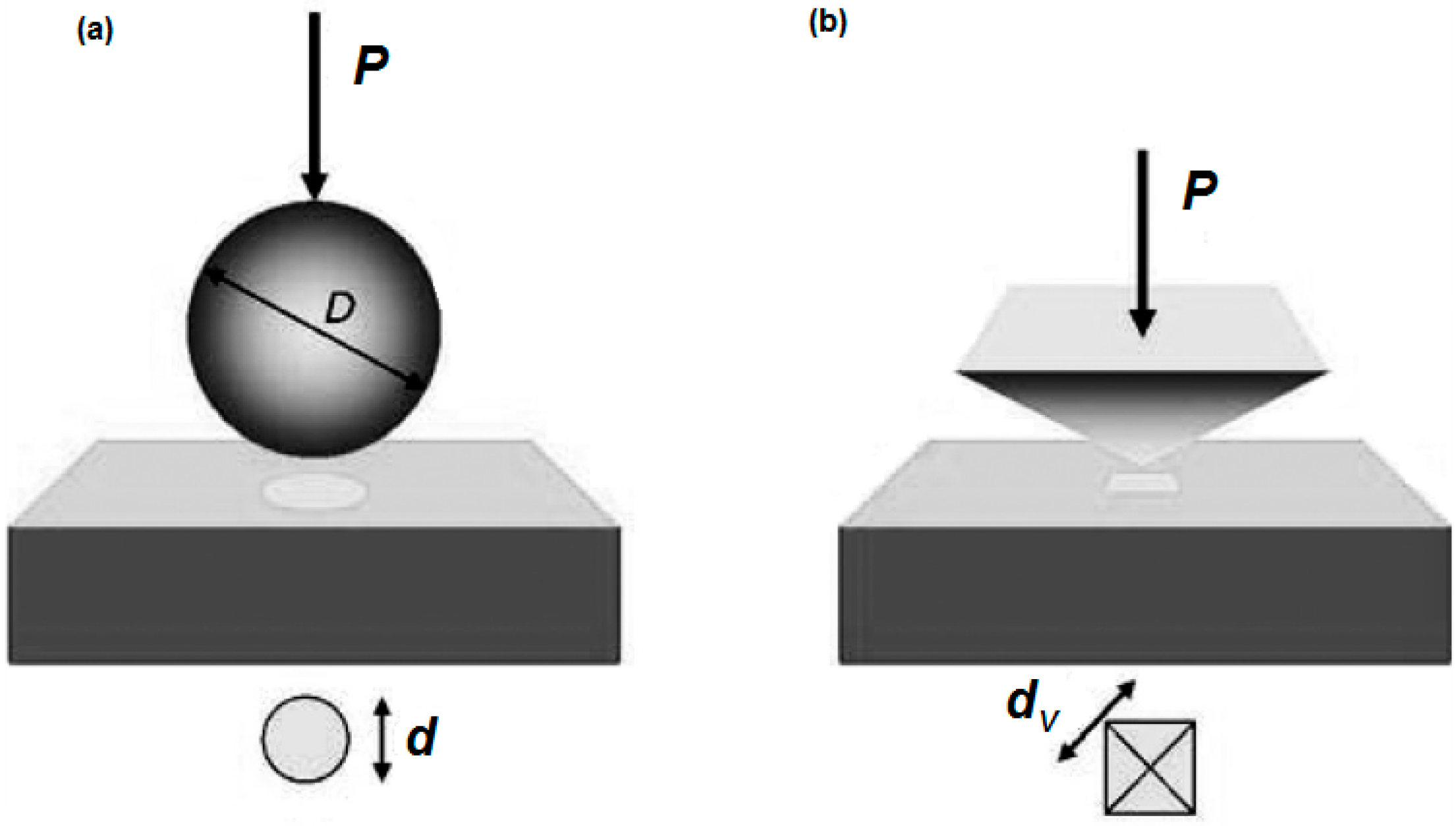
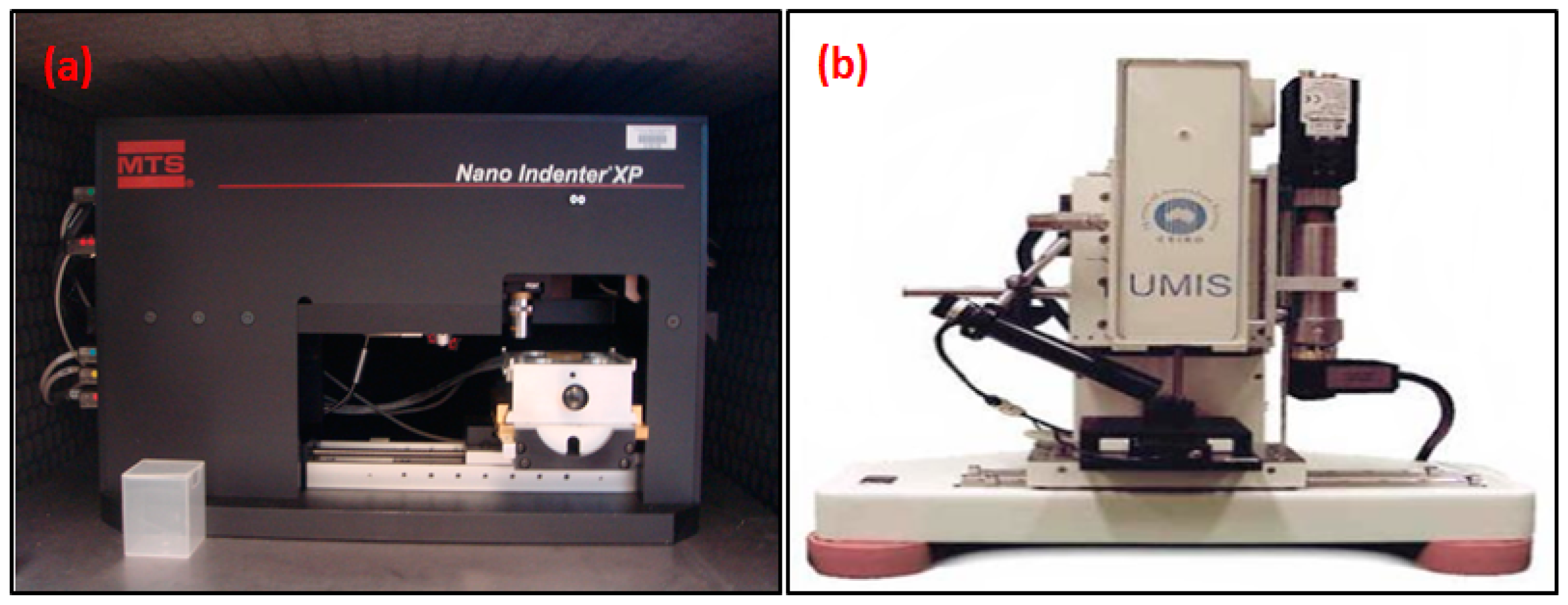
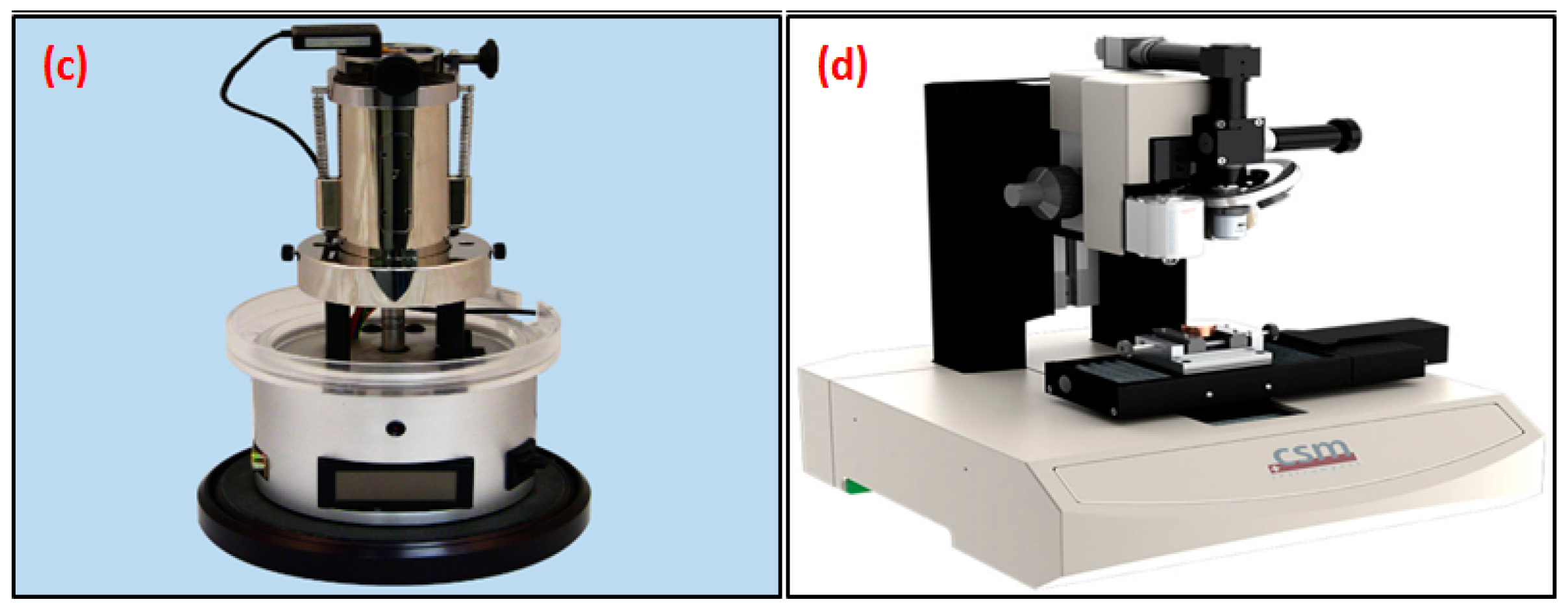
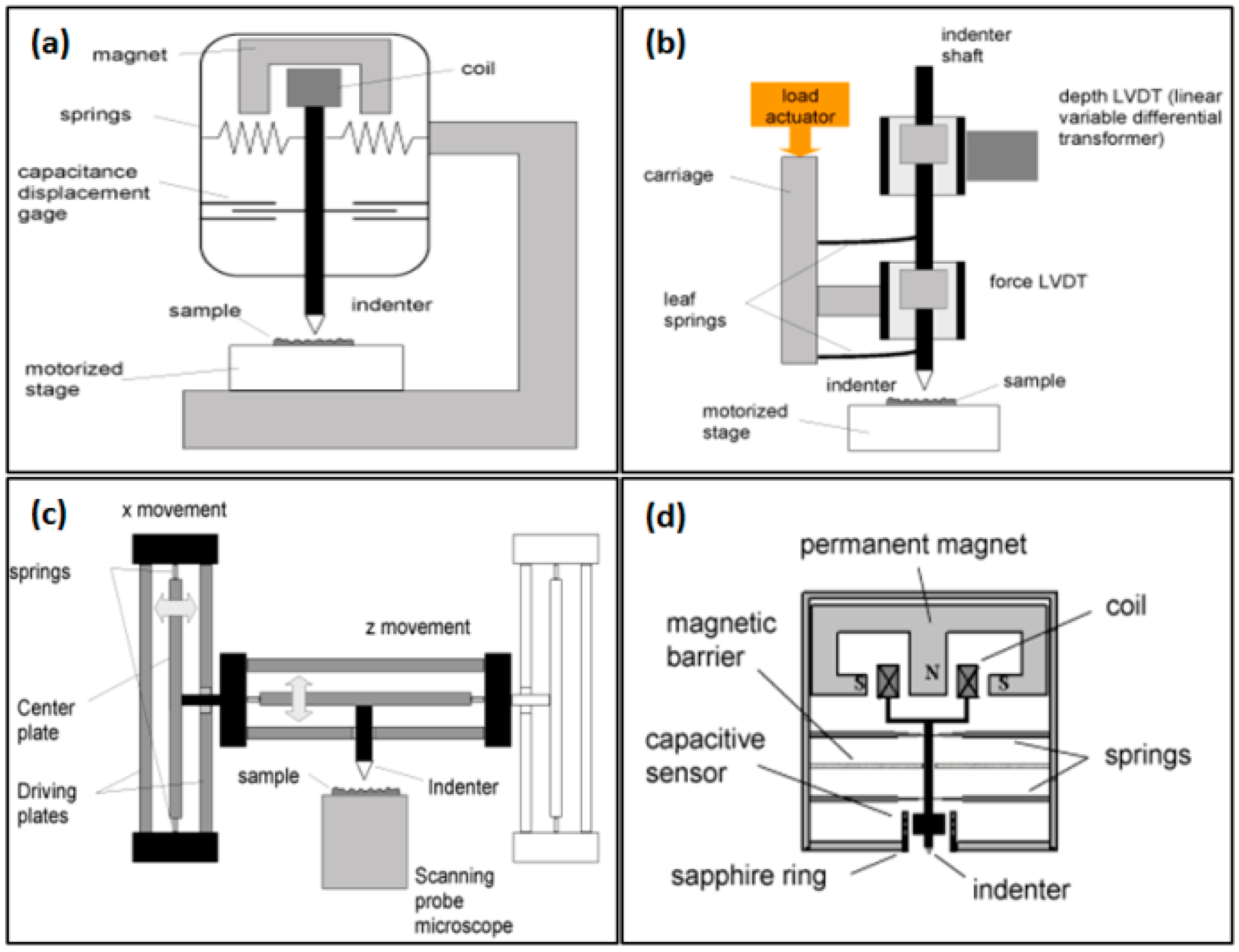
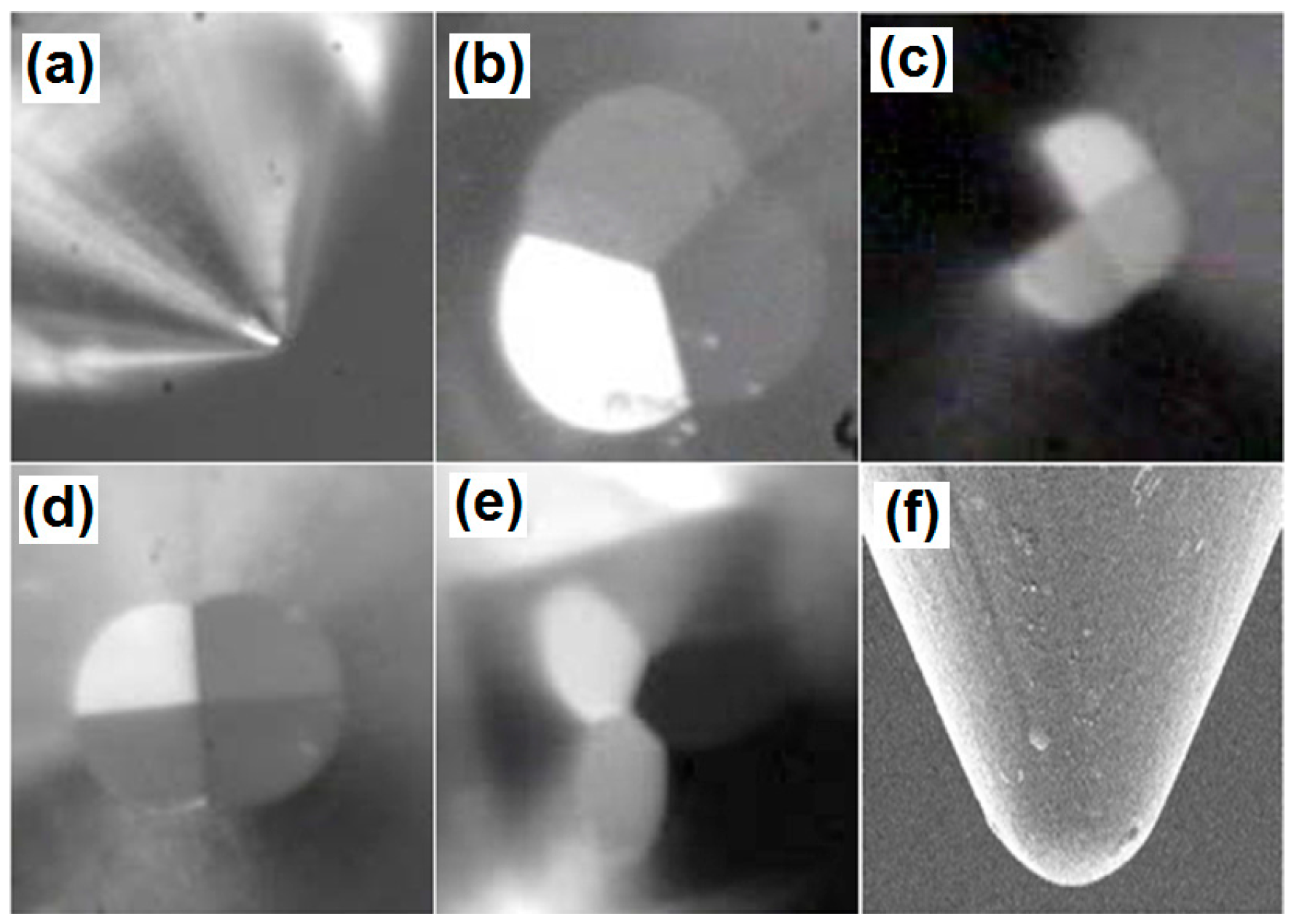
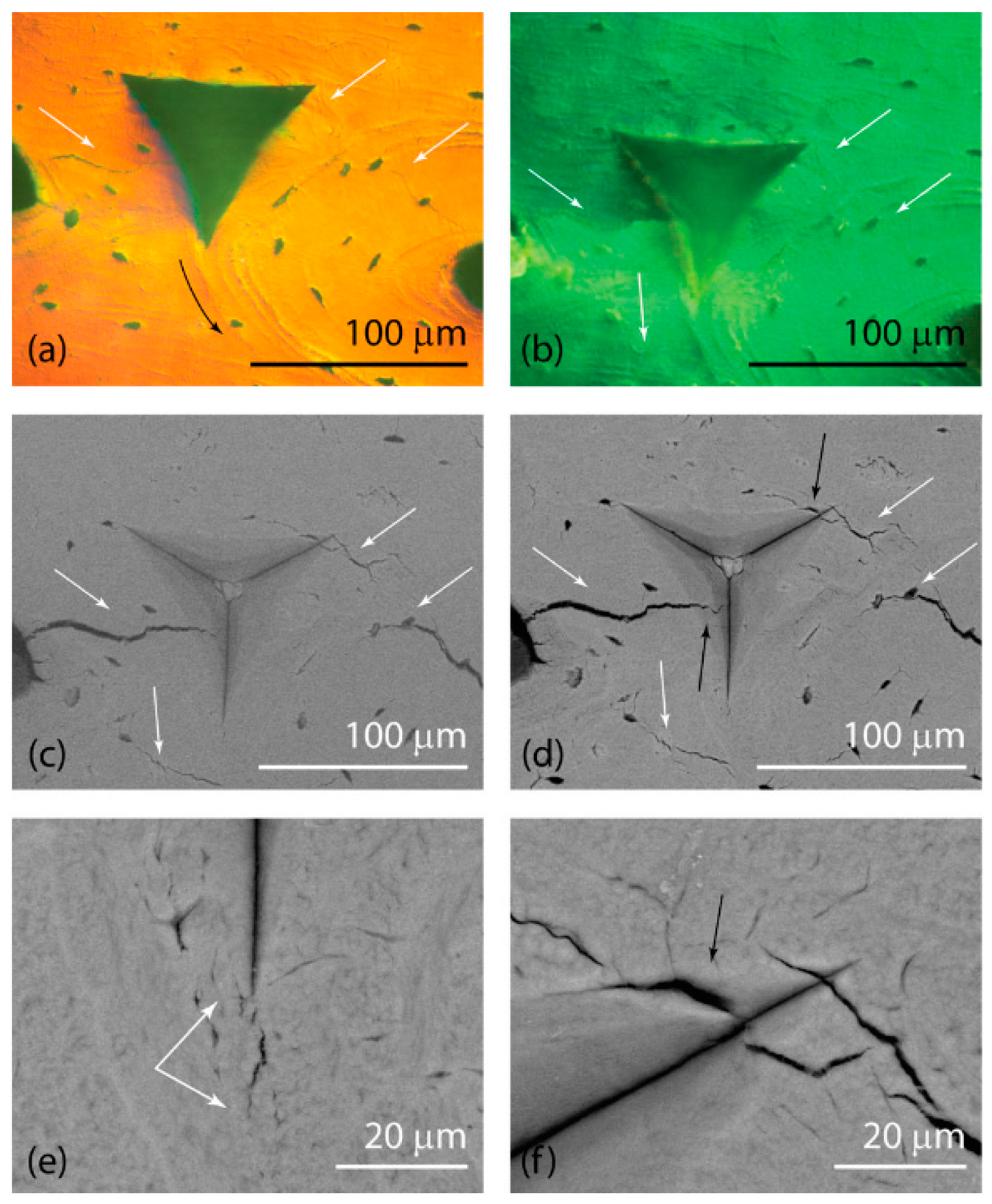
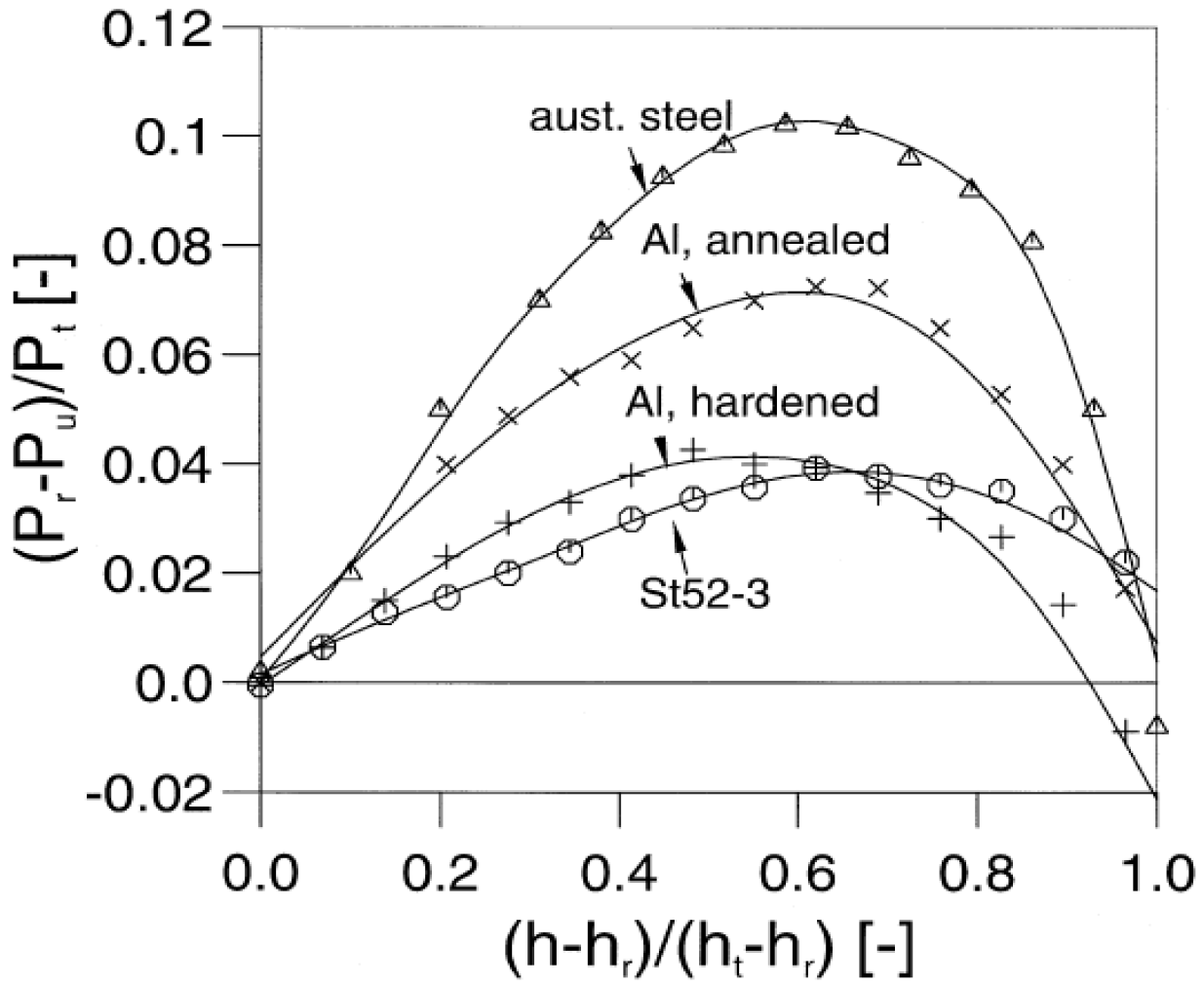
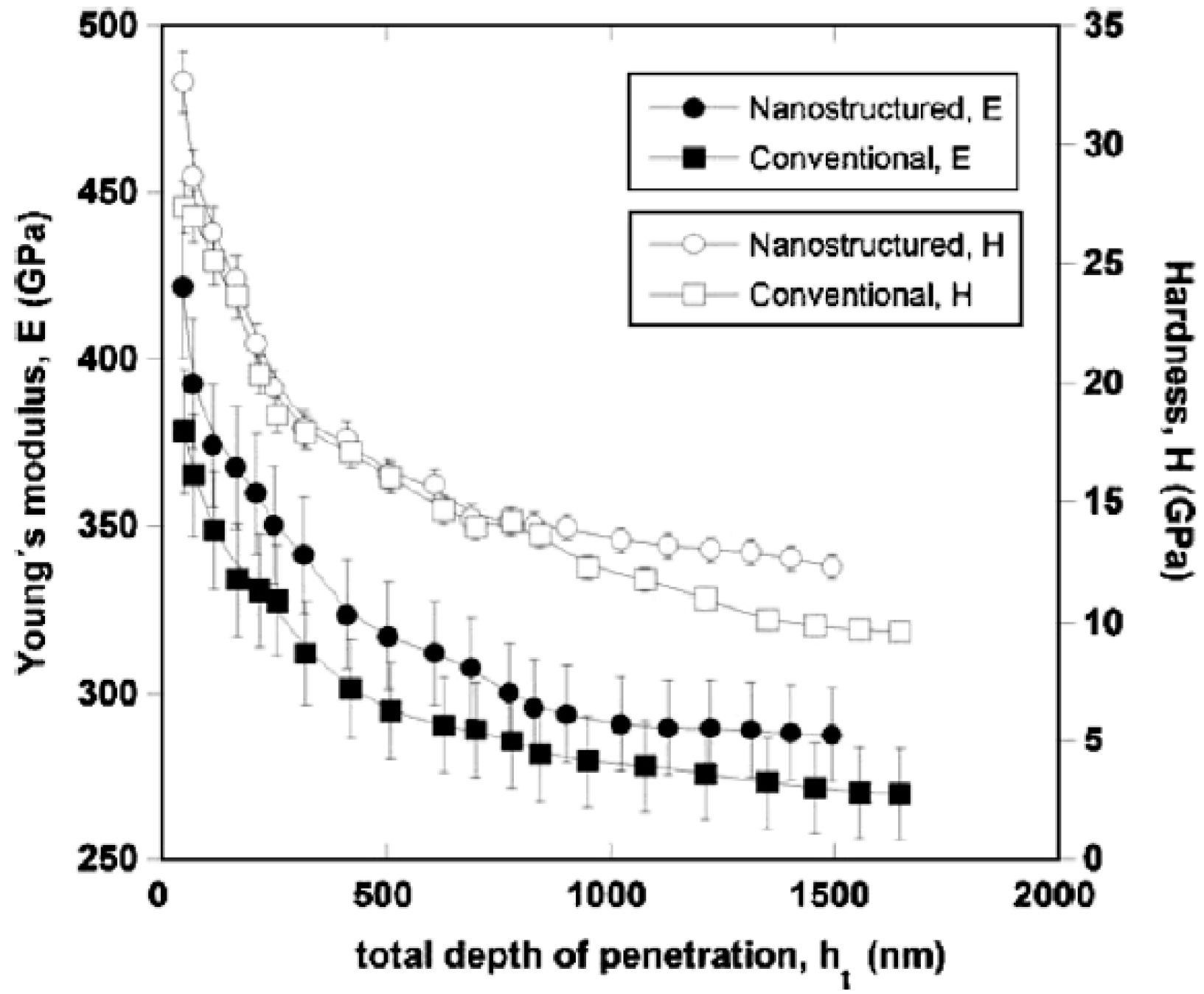

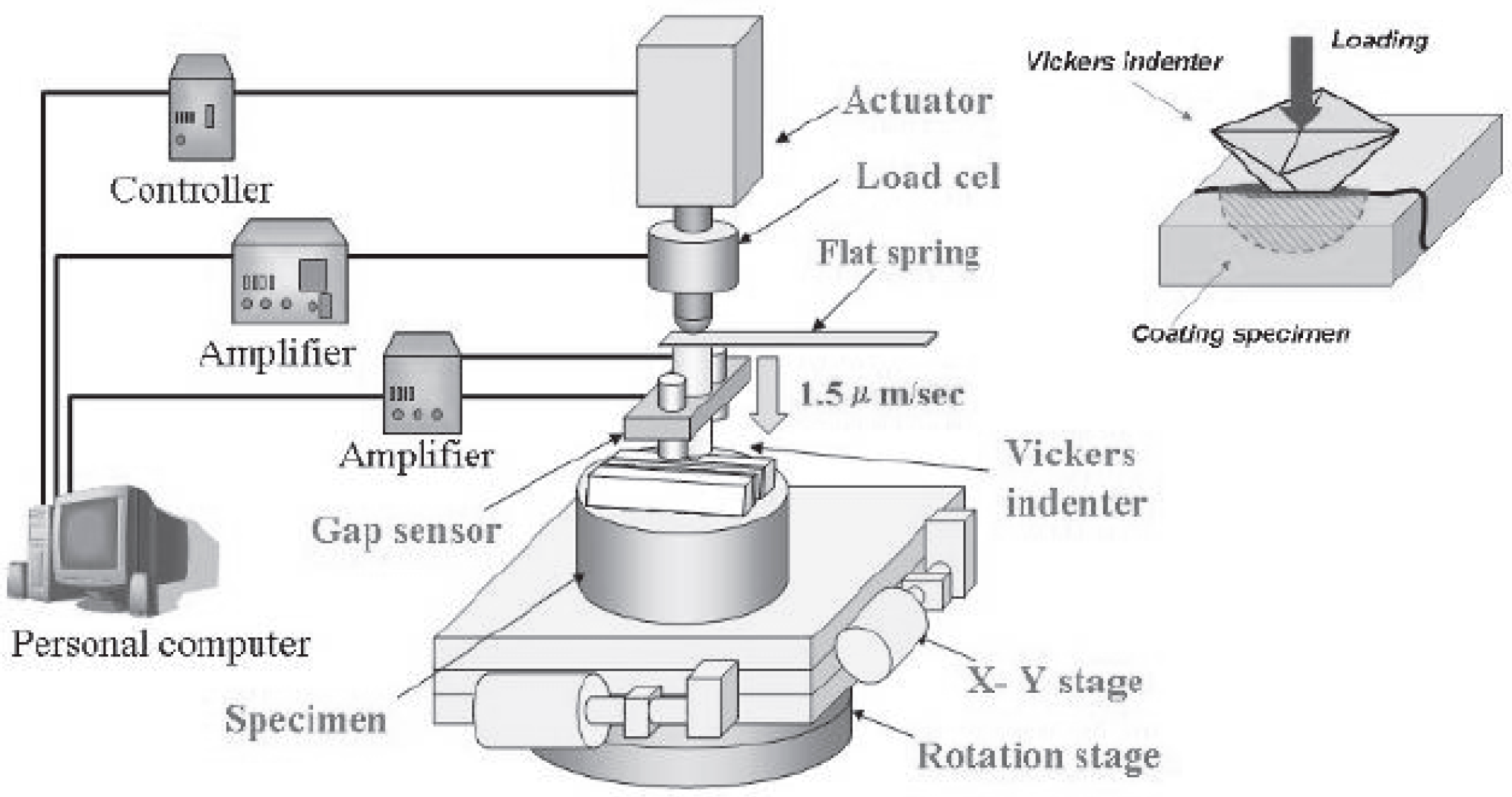


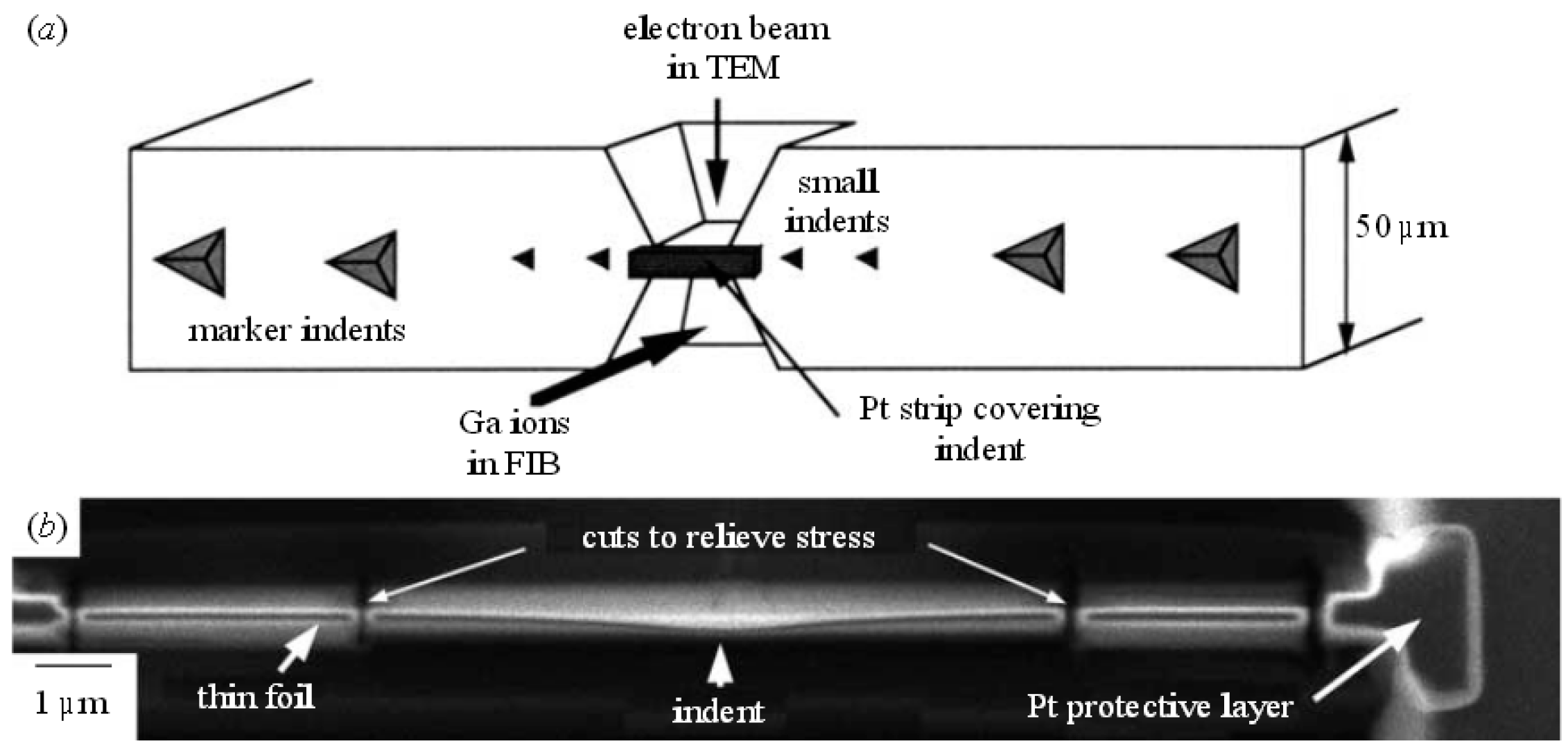
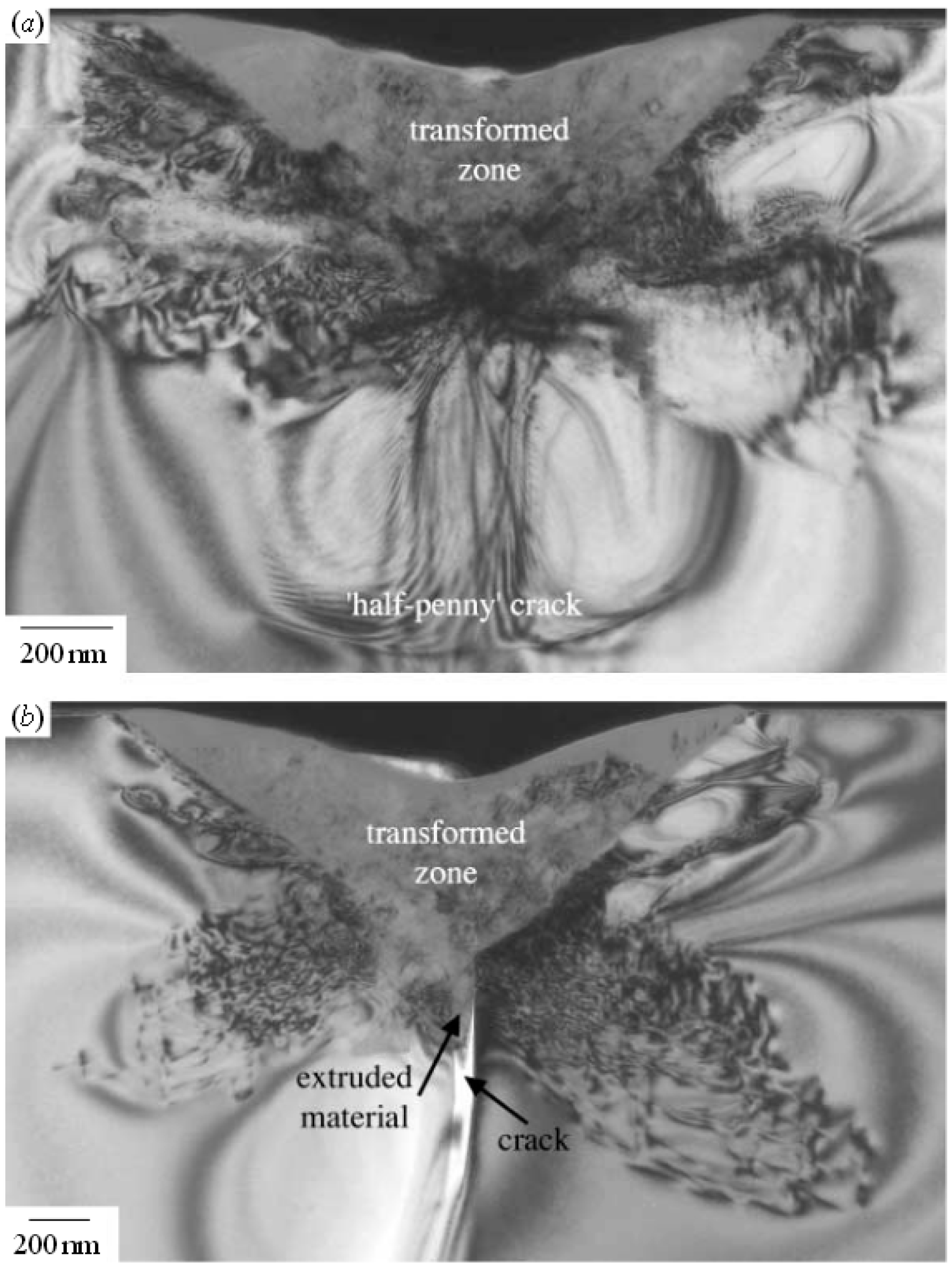
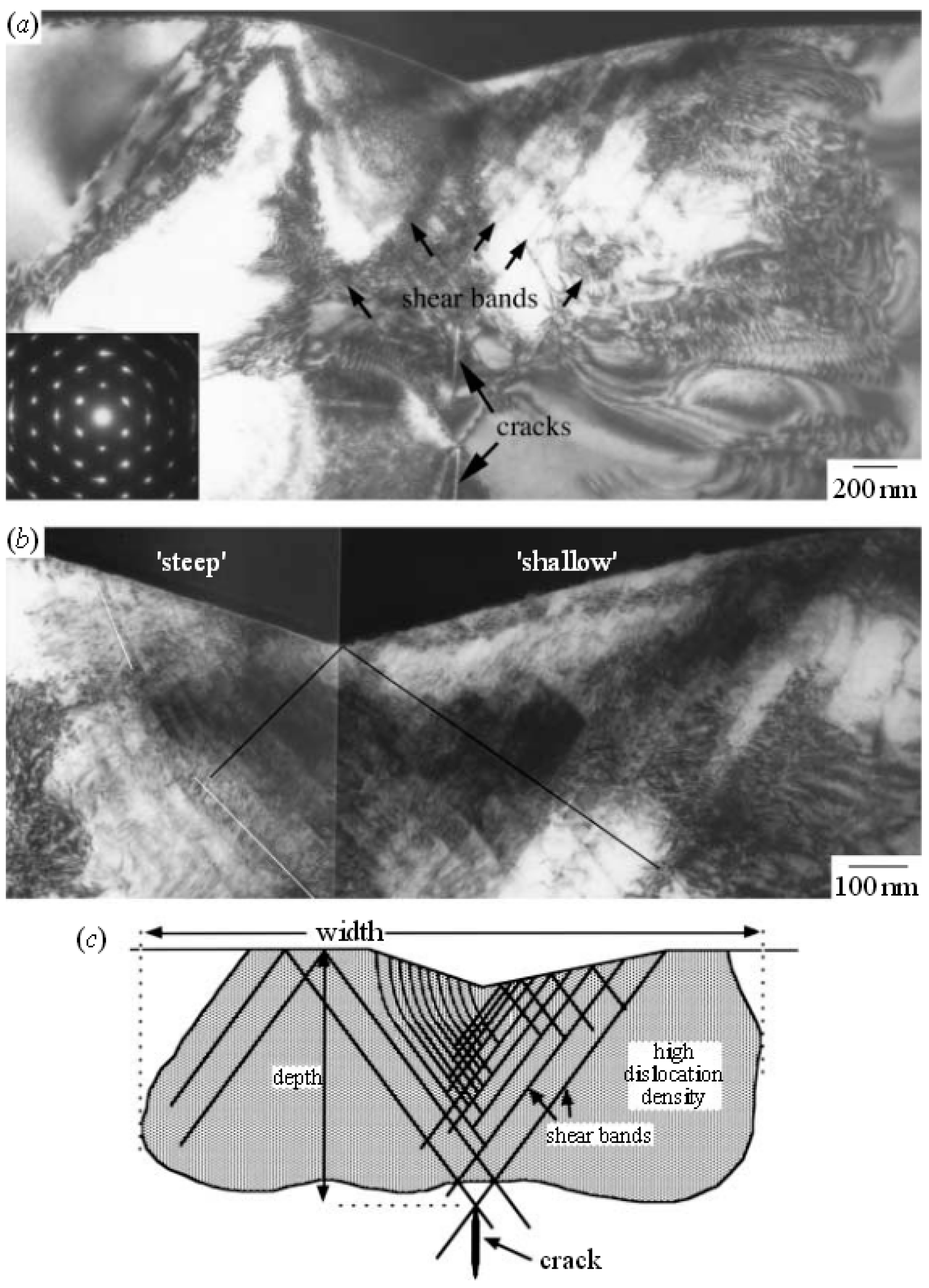
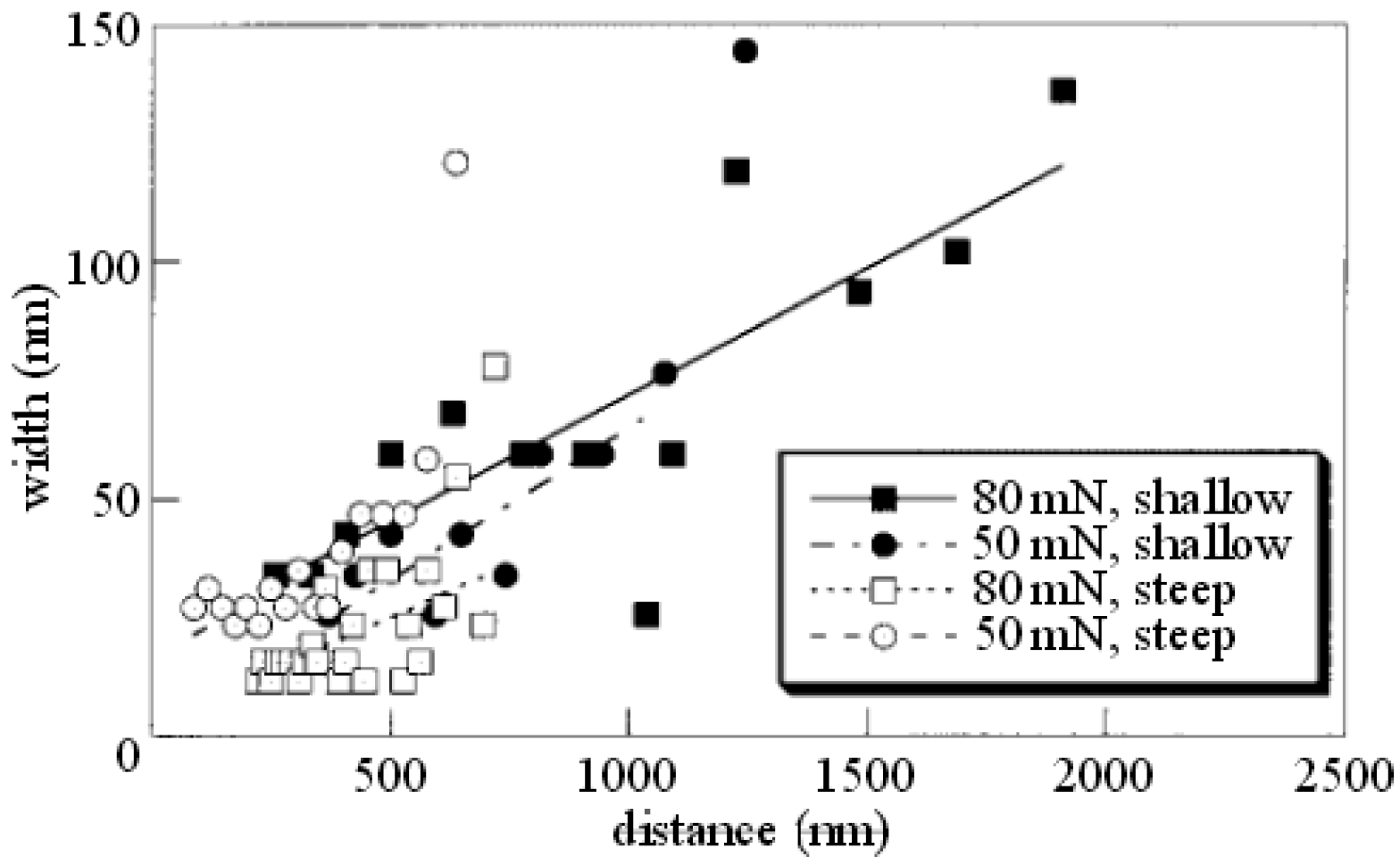


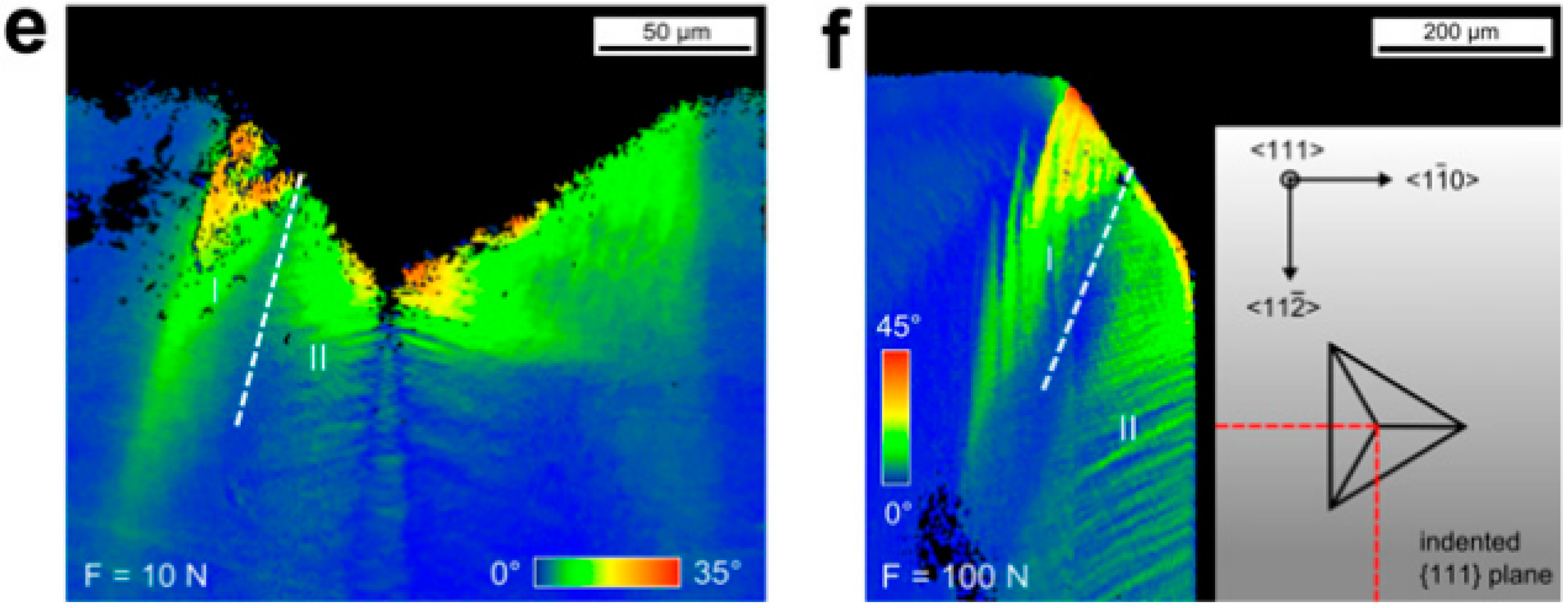
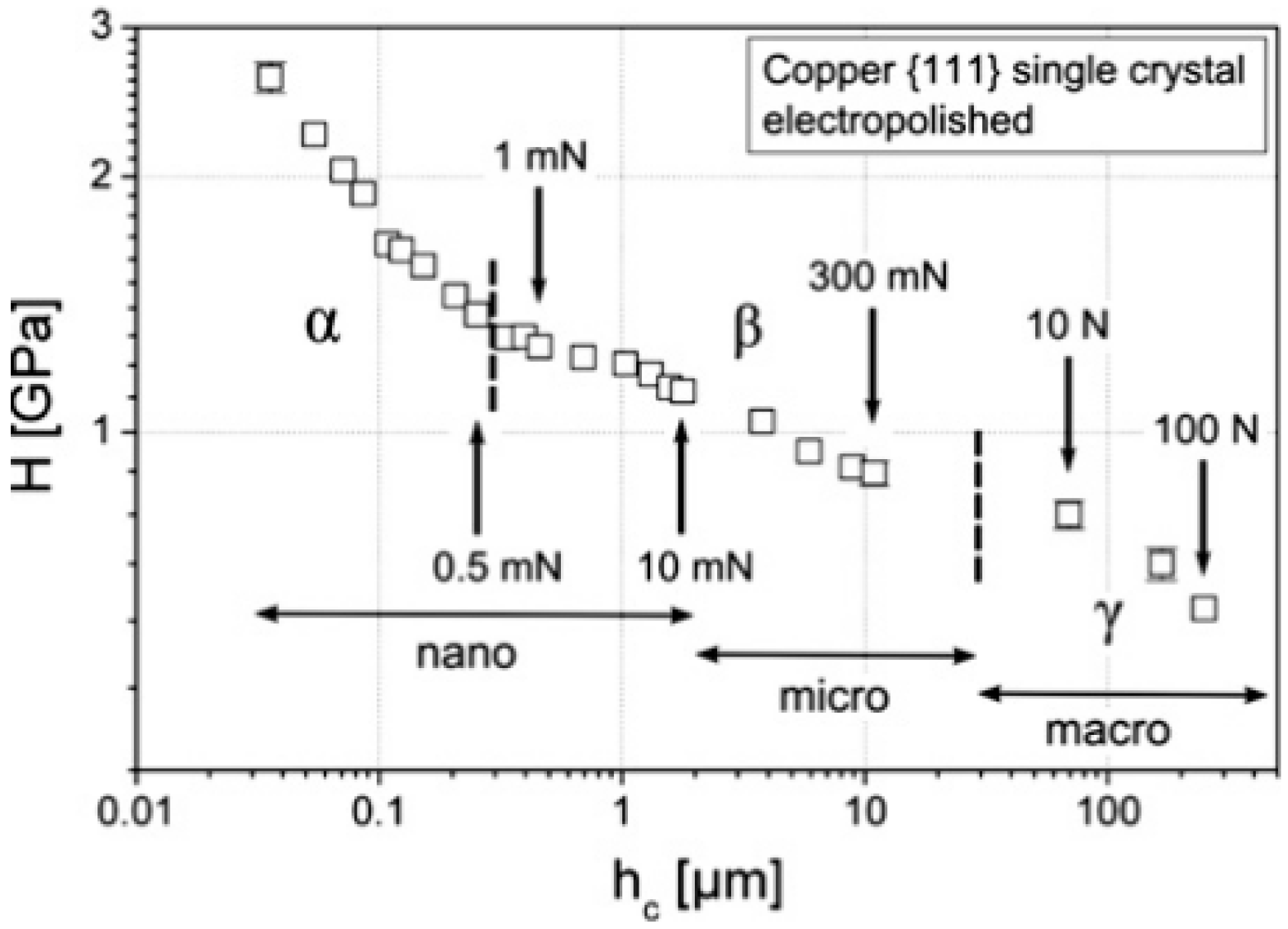




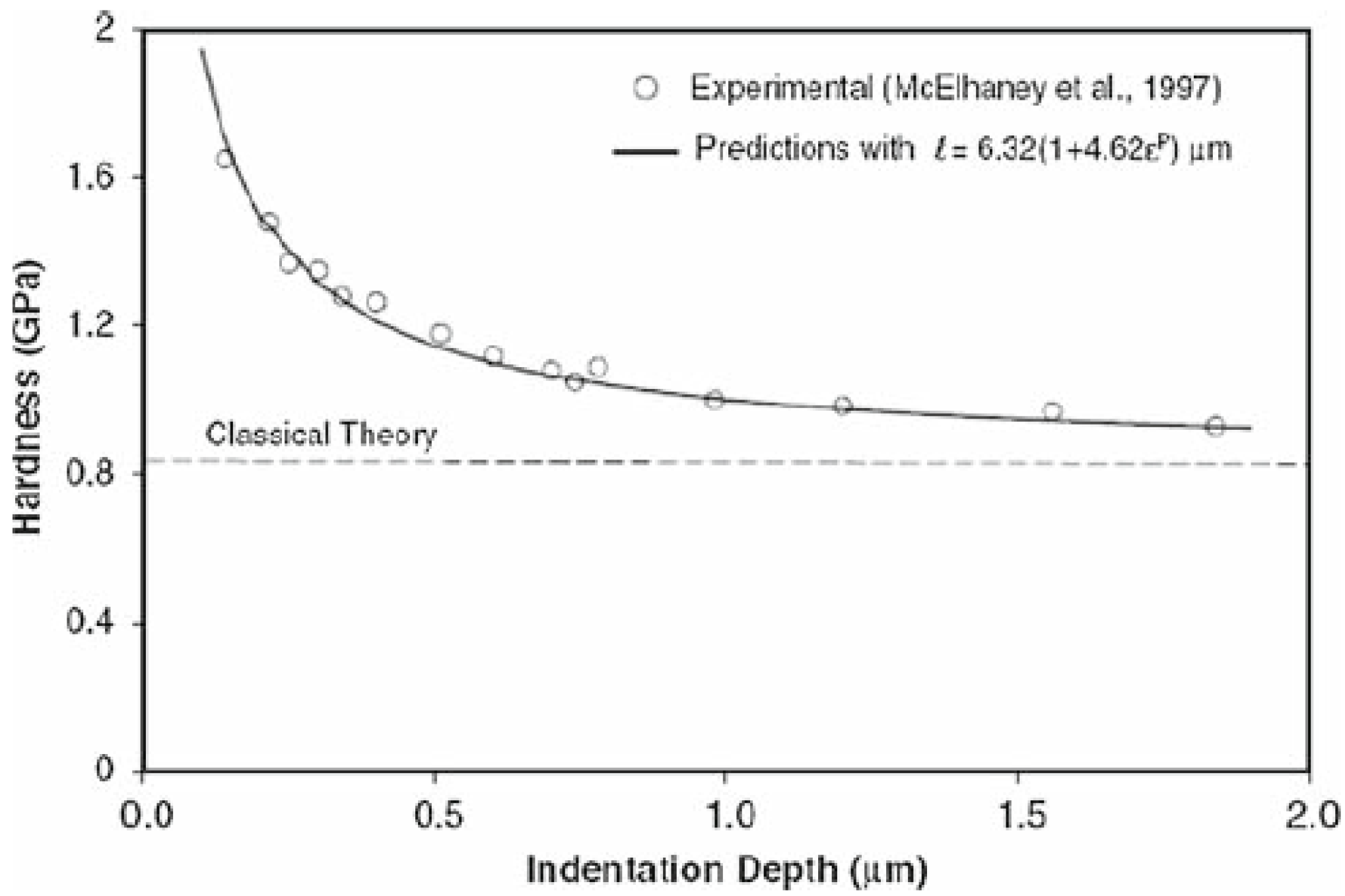



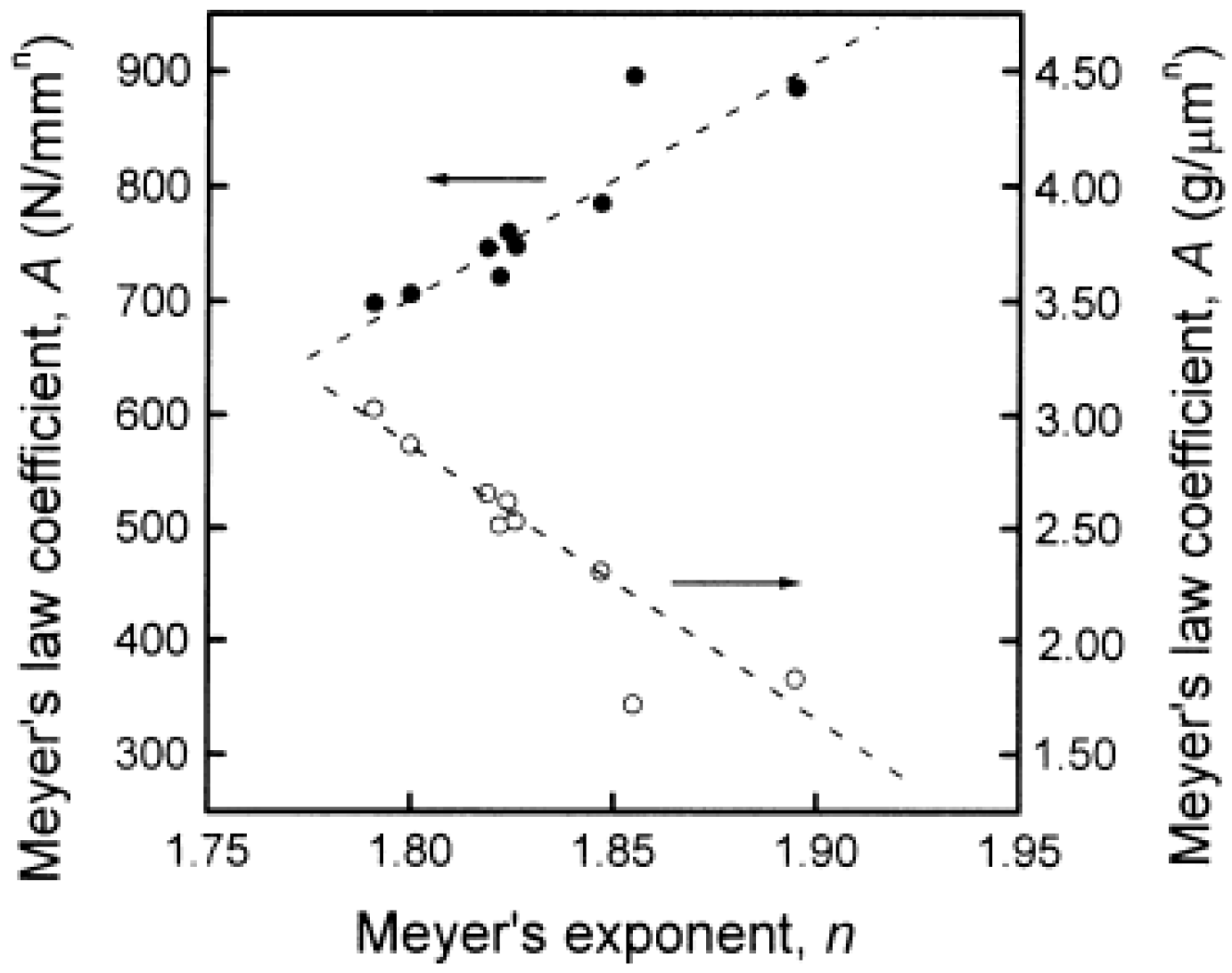
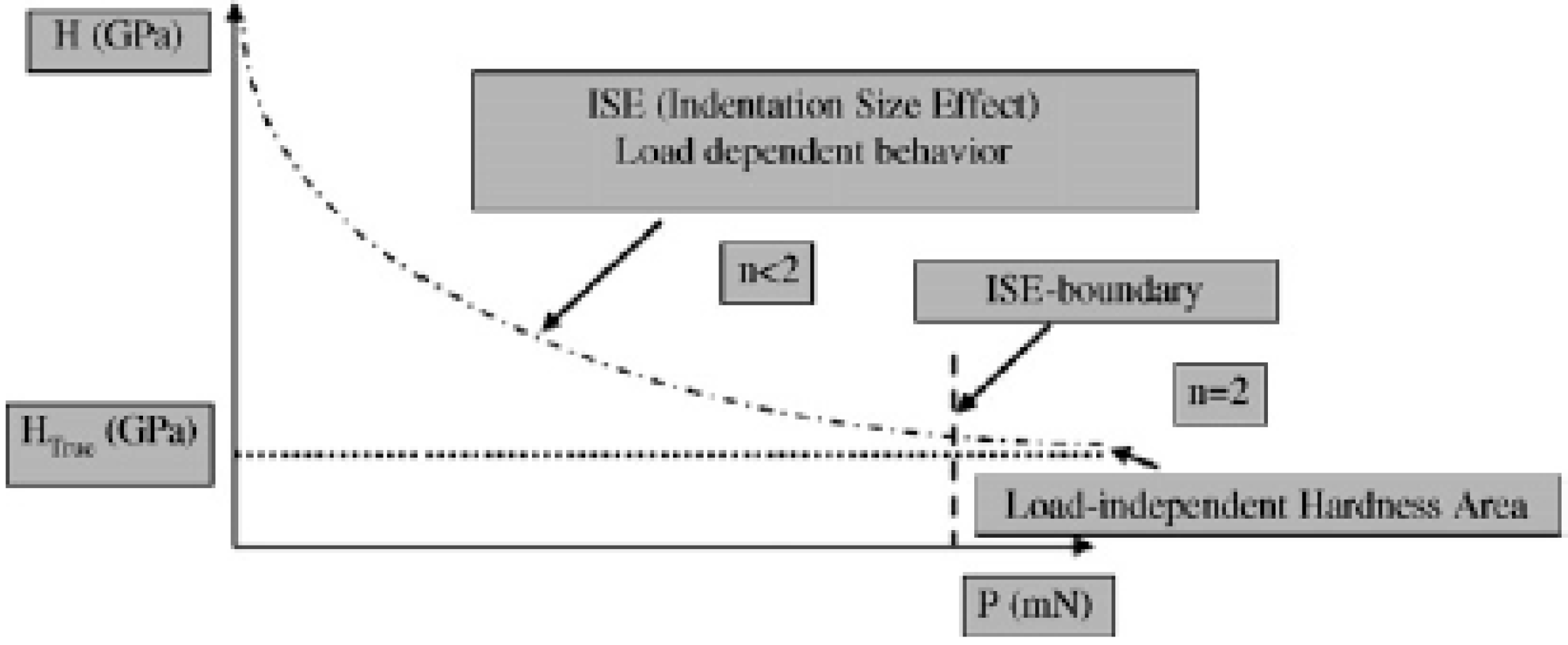
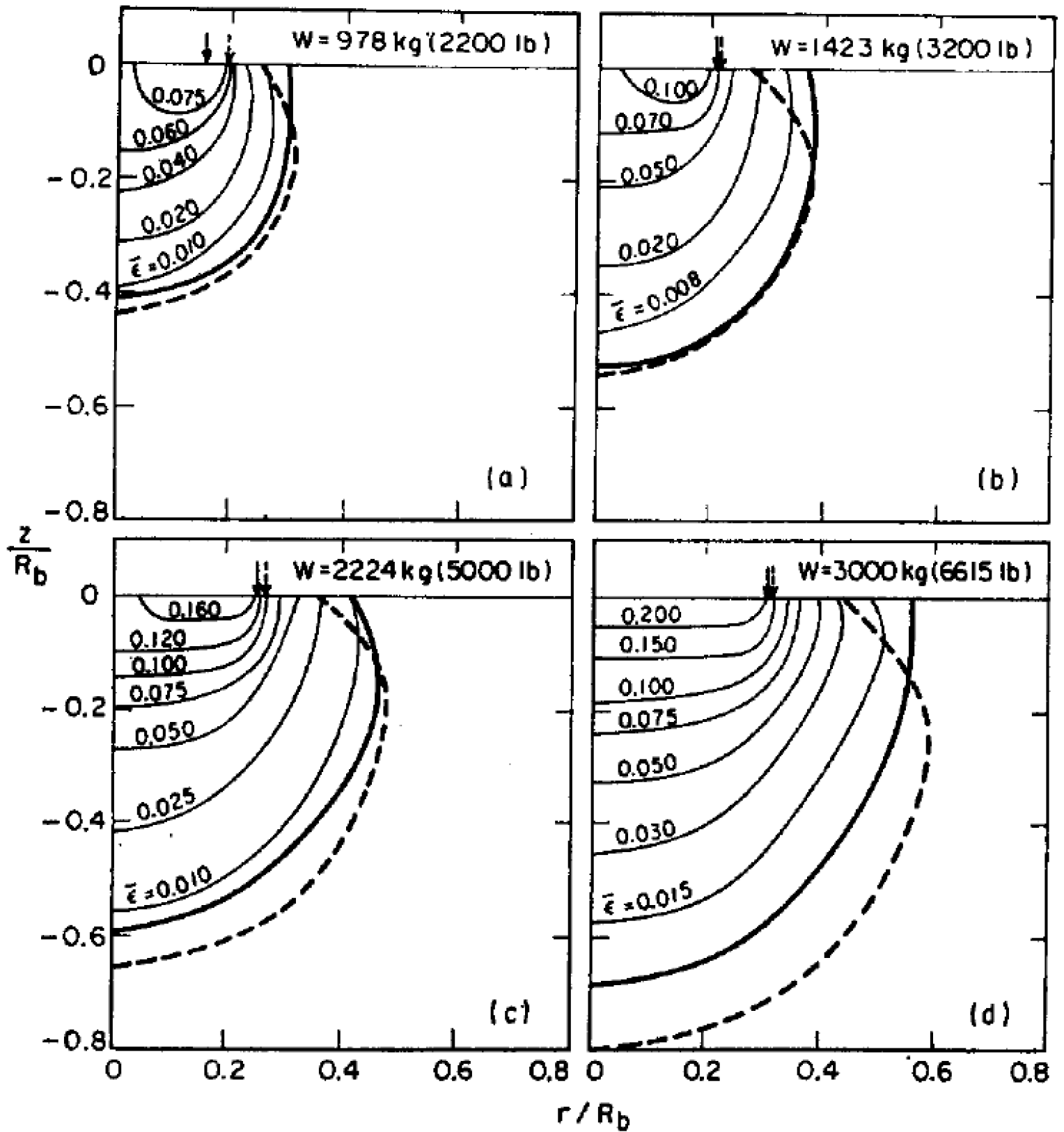


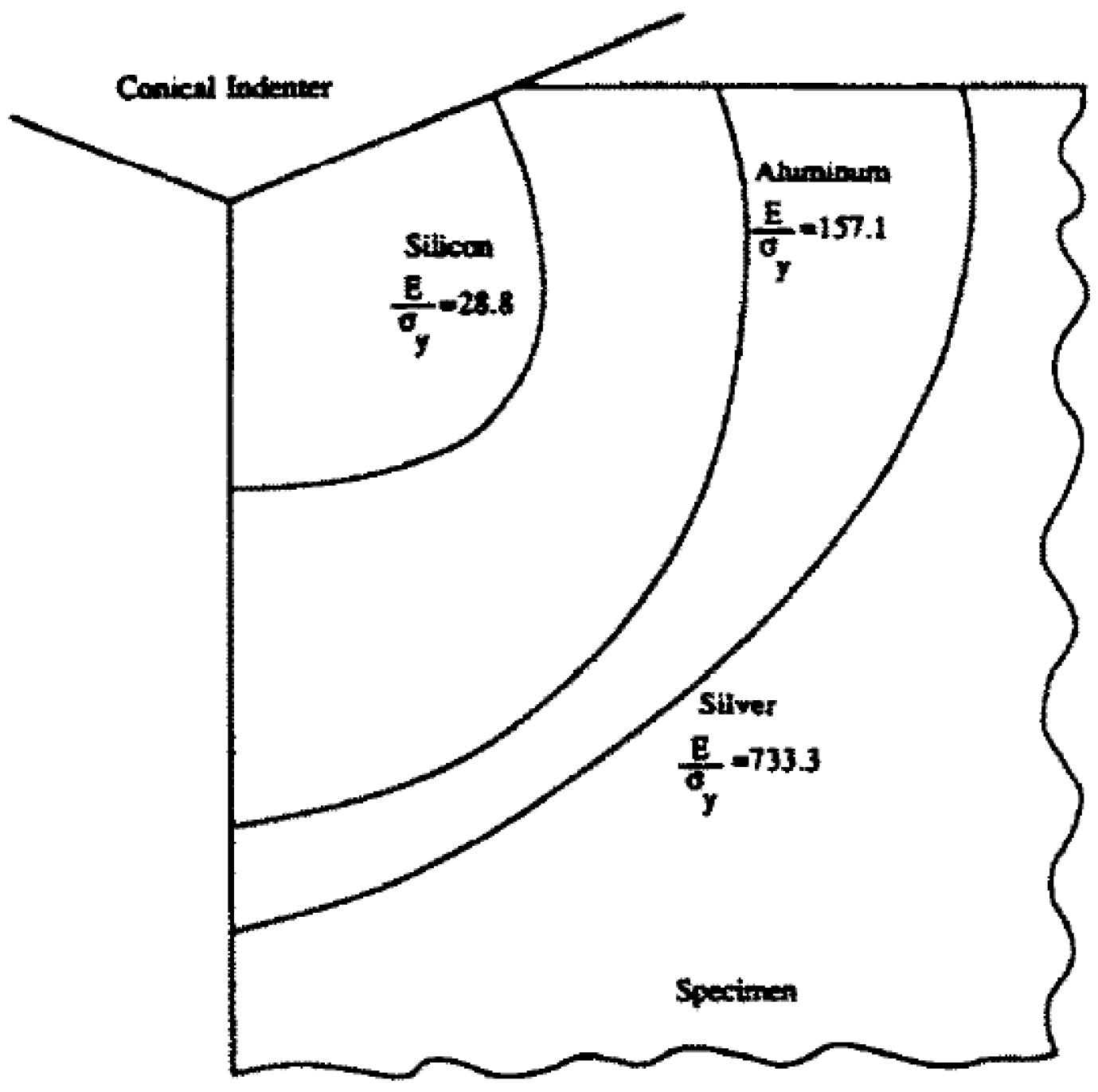
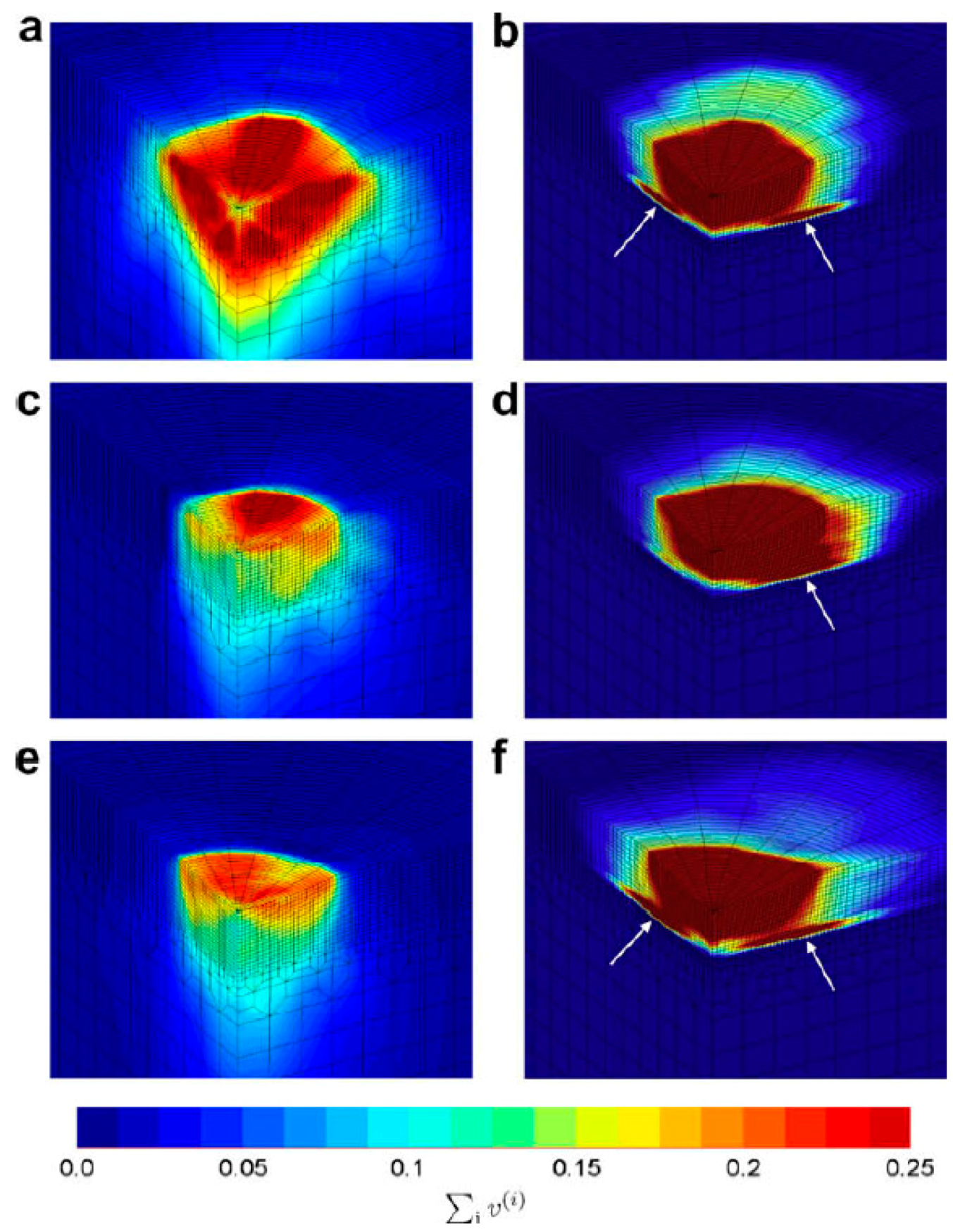
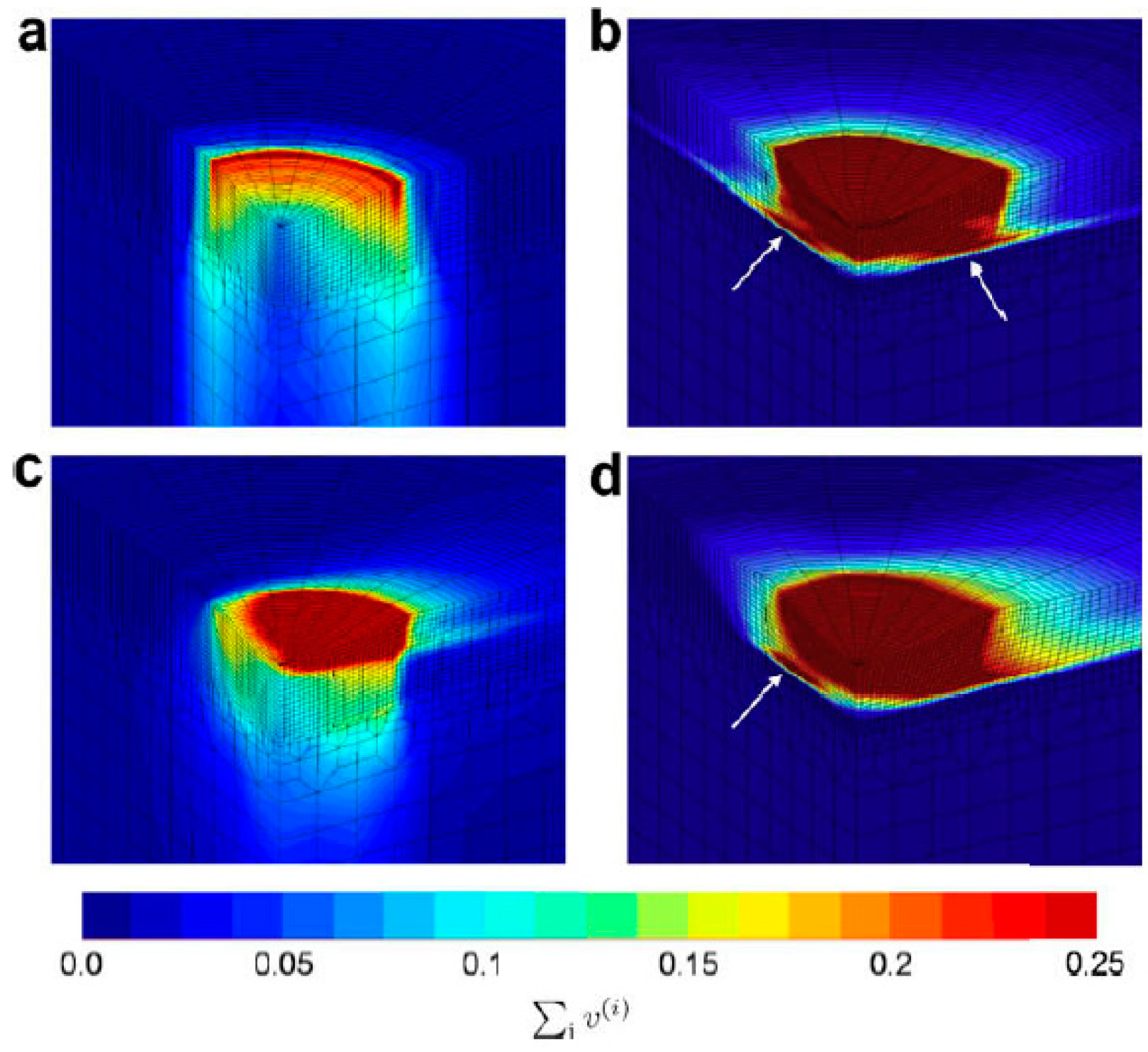
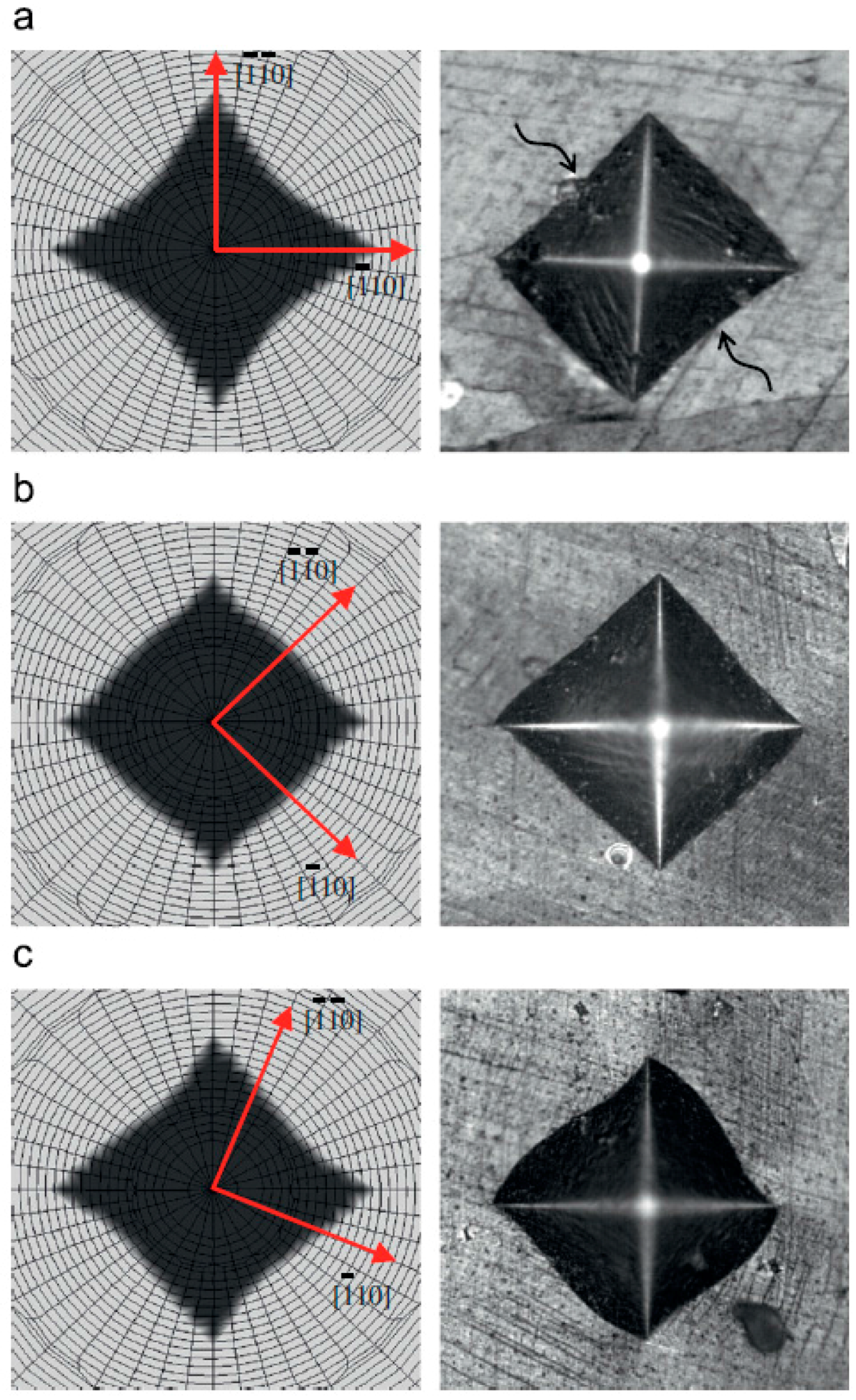
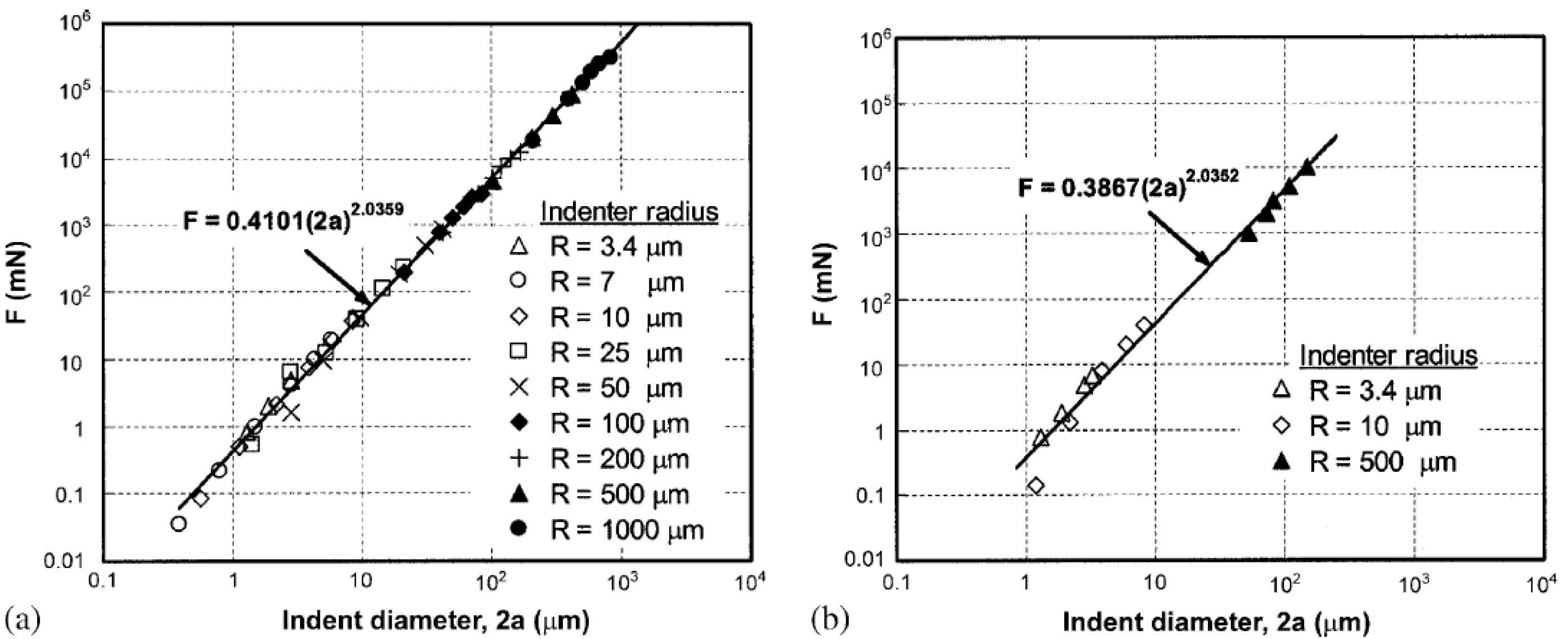
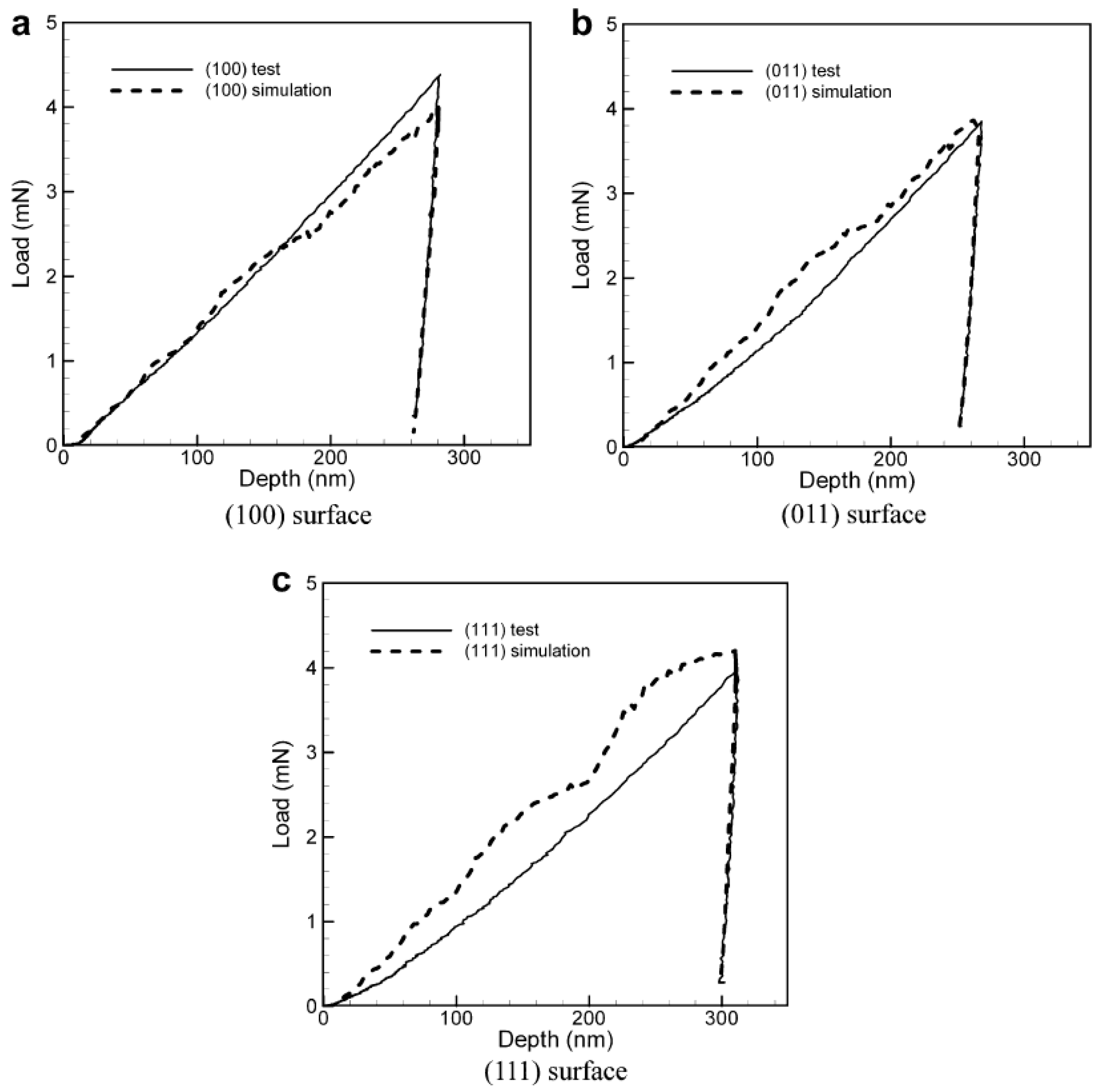
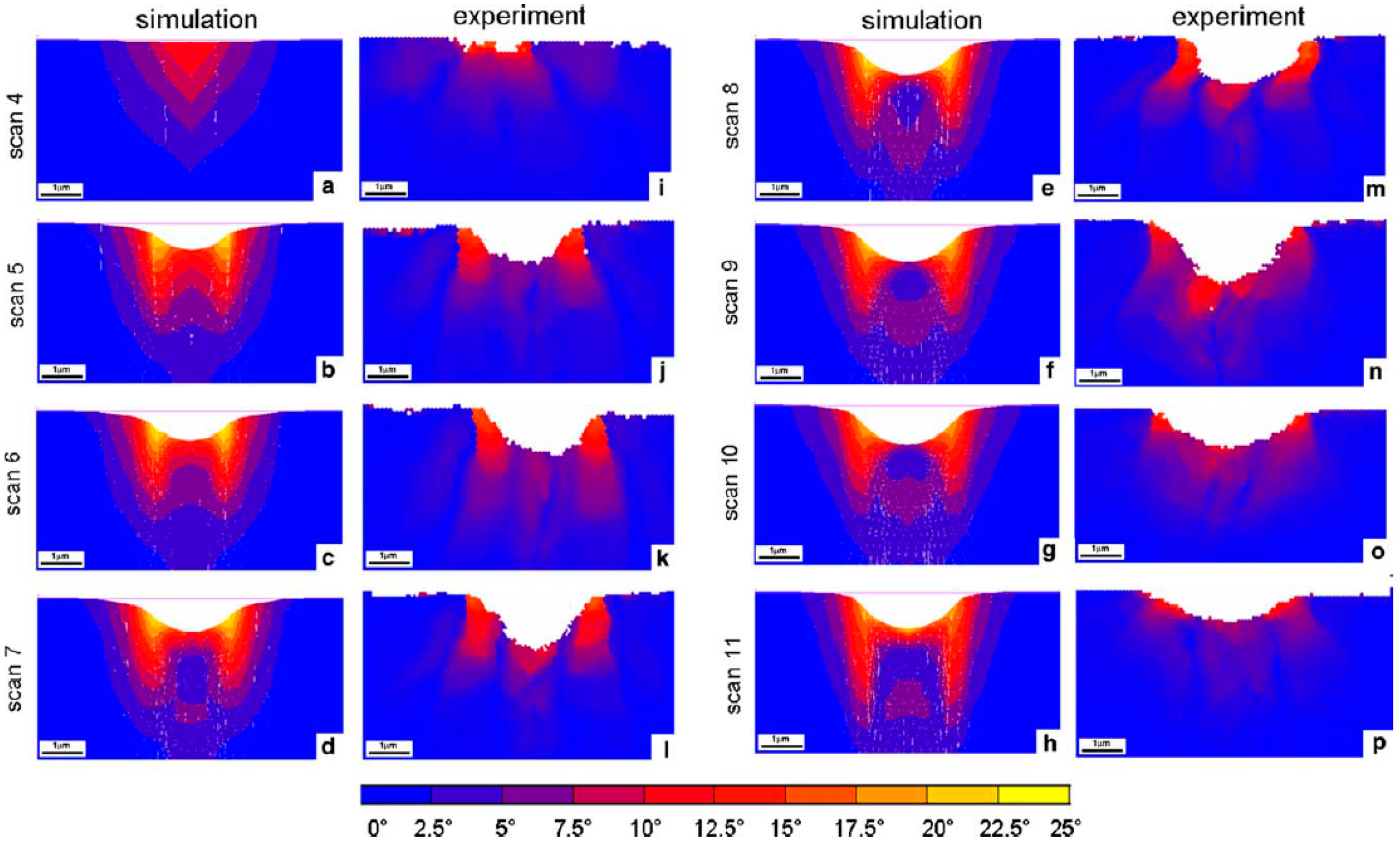
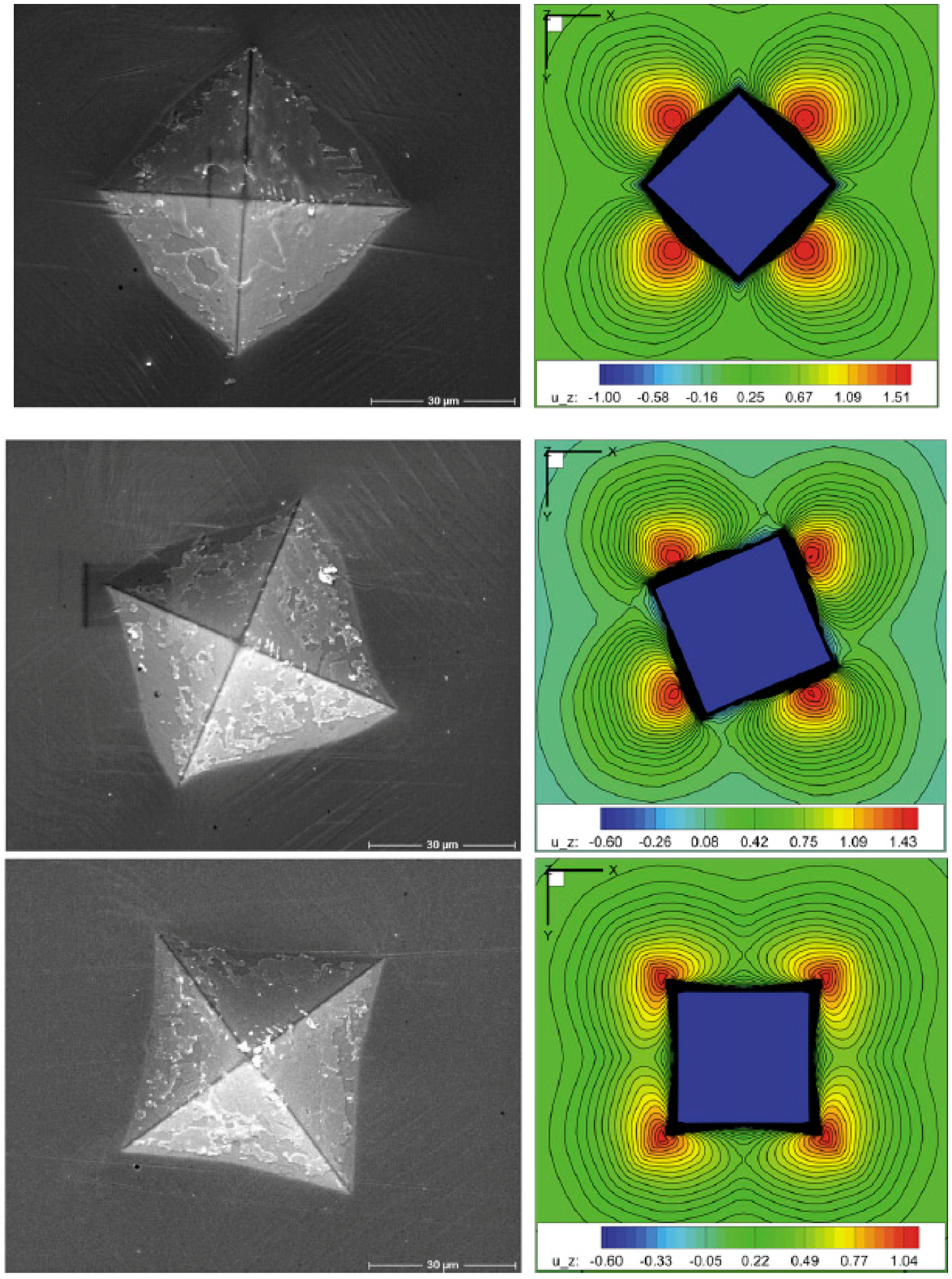

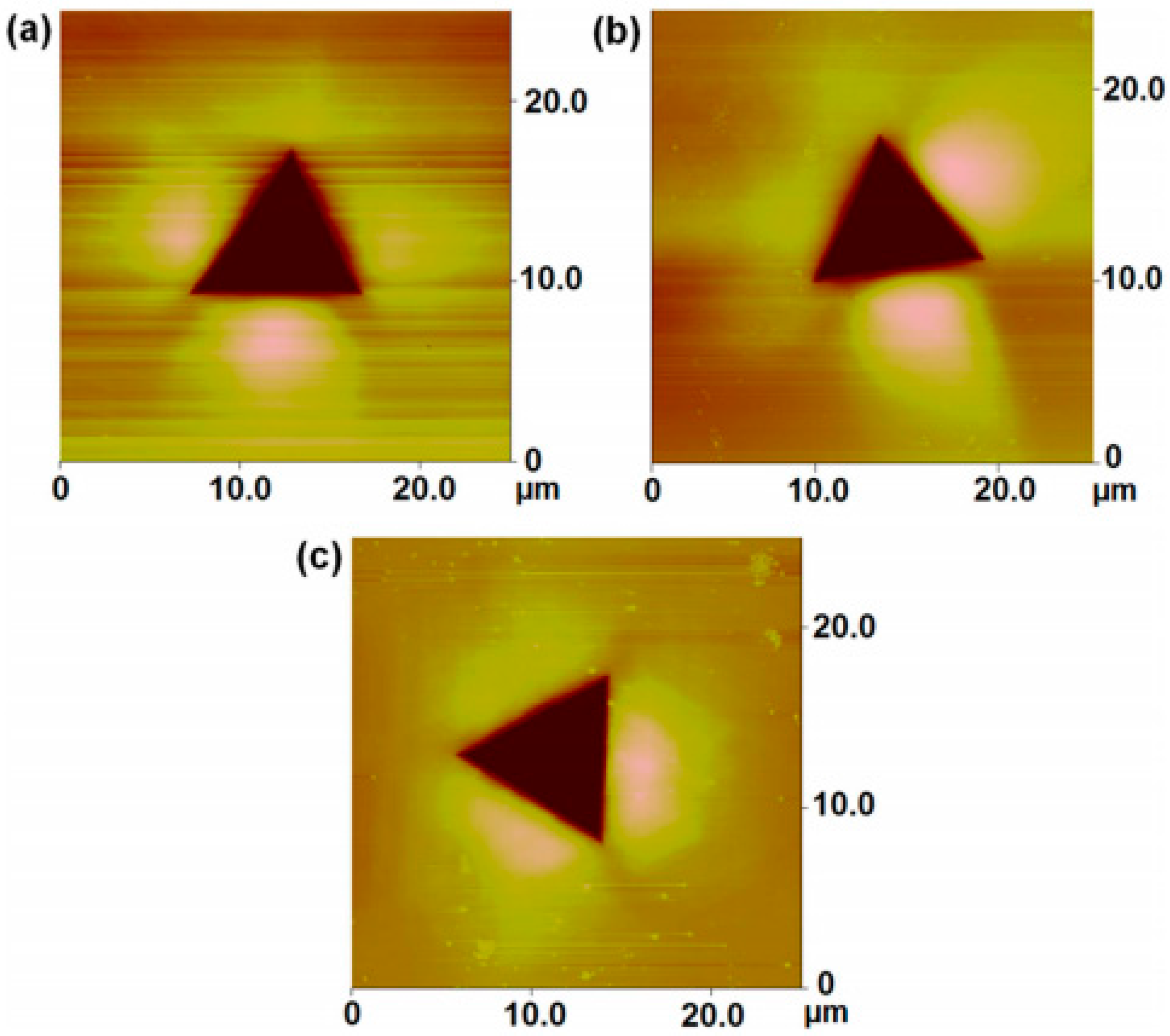


| Indenter Type | Projected Area | Semi Angle (θ) | Effective Cone Angle (a) | Intercept Factor | Geometry Correction Factor (β) |
|---|---|---|---|---|---|
| Sphere | A ≈ π2Rhp | N/A | N/A | 0.75 | 1 |
| Berkovich | A = 3hp2tan2θ | 65.3° | 70.2996° | 0.75 | 1.034 |
| Vickers | A = 4hp2tan2θ | 68° | 70.32° | 0.75 | 1.012 |
| Knoop | A = 2hp2tanθ1tanθ2 | θ1 = 86.25° θ2 = 65° | 77.64° | 0.75 | 1.012 |
| Cube-corner | A = 3hp2tan2θ | 35.26° | 42.28° | 0.75 | 1.034 |
| Conical | A = πhp2tan2a | a | a | 0.72 | 1 |
© 2017 by the authors. Licensee MDPI, Basel, Switzerland. This article is an open access article distributed under the terms and conditions of the Creative Commons Attribution (CC BY) license (http://creativecommons.org/licenses/by/4.0/).
Share and Cite
Liu, M.; Lin, J.-y.; Lu, C.; Tieu, K.A.; Zhou, K.; Koseki, T. Progress in Indentation Study of Materials via Both Experimental and Numerical Methods. Crystals 2017, 7, 258. https://doi.org/10.3390/cryst7100258
Liu M, Lin J-y, Lu C, Tieu KA, Zhou K, Koseki T. Progress in Indentation Study of Materials via Both Experimental and Numerical Methods. Crystals. 2017; 7(10):258. https://doi.org/10.3390/cryst7100258
Chicago/Turabian StyleLiu, Mao, Jhe-yu Lin, Cheng Lu, Kiet Anh Tieu, Kun Zhou, and Toshihiko Koseki. 2017. "Progress in Indentation Study of Materials via Both Experimental and Numerical Methods" Crystals 7, no. 10: 258. https://doi.org/10.3390/cryst7100258








